YESTER LION COUNTRY SAFARI (CALIFORNIA) HOURS:
Open every day of the year, rain or shine, at 9 a.m. until:
Summer — June 1 to Labor Day — 6:00 p.m. Fall — Day after Labor Day to October 31 — 5:00 p.m. Winter — November 1 to March 31 — 3:30 p.m. Spring — April 1 to May 31 — 5:00 p.m.
Prices and operating hours subject to change without notice.
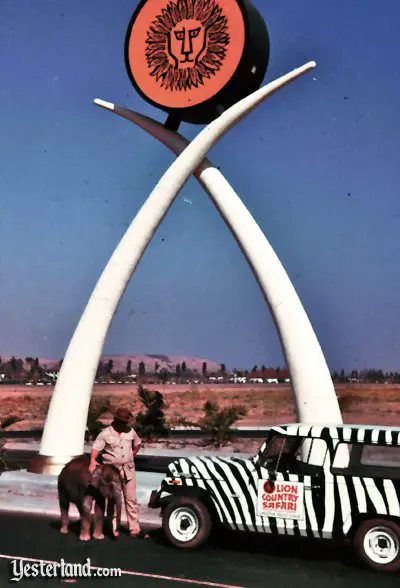
According to the brochure, “Go Wild! Drive thru Lion Country Safari African Wildlife Preserve.”
You don’t have to go to Africa for this African Safari. It’s only a 20-minute drive from Yesterland. Lion Country Safari is 40 miles from Downtown Los Angeles or 64 miles from Downtown San Diego, according to the brochure. Just head down the San Diego Freeway to the Moulton Parkway off-ramp. Your safari awaits you right on the Irvine Ranch in Orange County, California.
You’ll be greeted by a sign that reads, “No Trespassing. Violators Will Be Eaten! Lion Country Safari.”
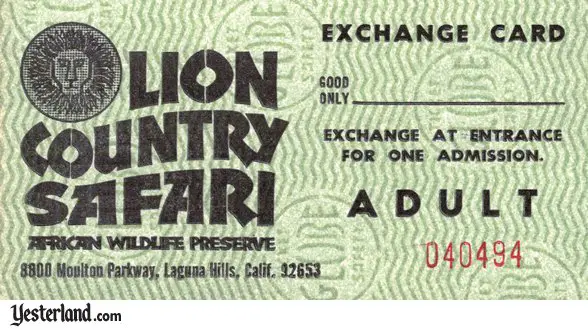
Drive up to a ticket window. Adults are $3.25; children five through eleven are $1.50; four and under are free. There is no charge for parking.
If you’re driving a convertible, you won’t be allowed to drive it through the safari. (They don’t really want the lions to eat you.) Park your convertible at the Hertz Hut and rent an air-conditioned sedan or safari-type vehicle at nominal charge.
Did you bring your pets with you? According to the brochure, “Domestic animals are not permitted in automobiles touring the preserve. First-rate accommodations are provided for them, free, at the Kal Kan Kennel Club.”
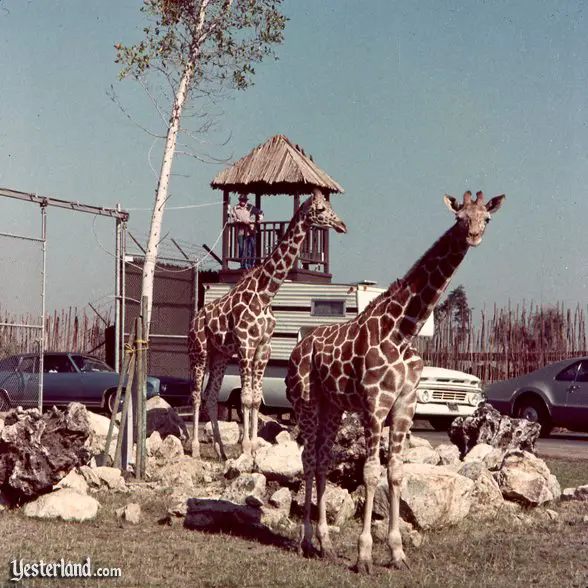
A ranger watches from a tower to make sure everything is okay.
You’ll see more than just lions at California’s Lion Country Safari. You can drive your Impala among the antelope. The cheetahs can outrun your Cougar—you have a speed limit, but they don’t. Giraffes will tower over your Pinto. Curious ostriches might peck at your Falcon.
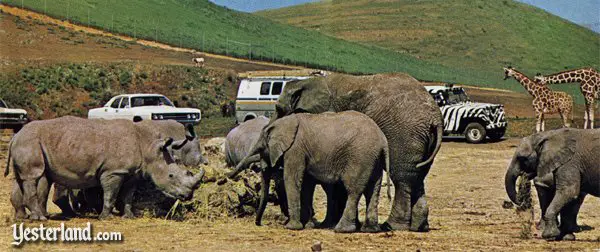
Experience an authentic safari in your family car.
The animals have the right-of-way. Given the size of the elephants and rhinoceroses, nobody should debate this rule.
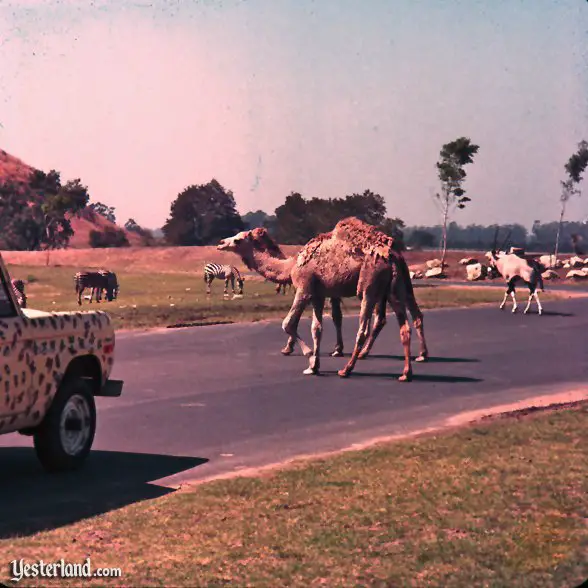
Camels and zebras and gnus, oh my!
The zebras are glad that they’re separated from the lions by fences. Park guests are glad that the fences are hidden in ditches so that it feels like driving through an African savanna, not through a series of fenced enclosures.
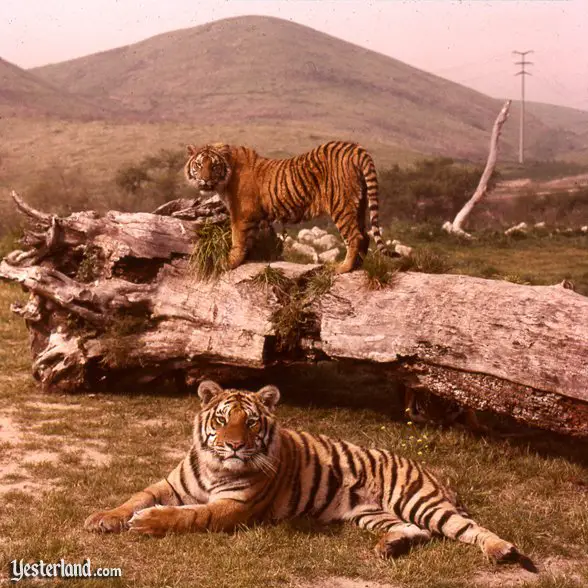
Keep your windows rolled up!
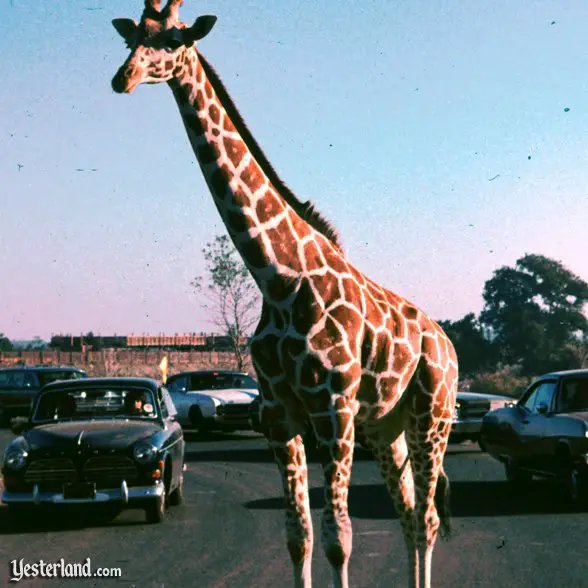
Over 400 animals call Lion Country Safari “home.”
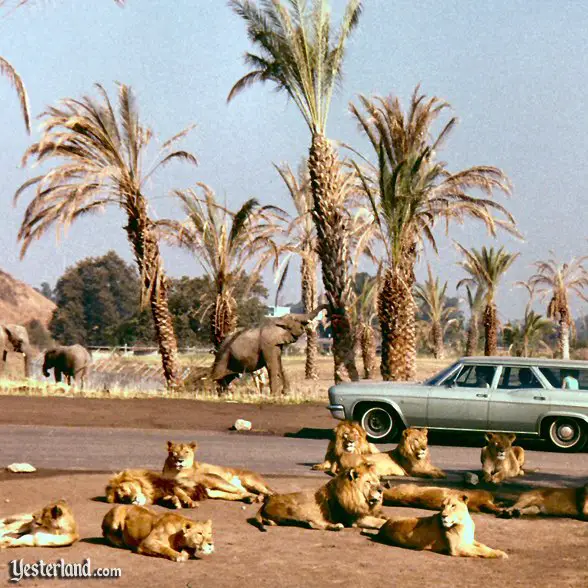
The stars of the show
The highlight of your safari is being surrounded by lions. The only thing between you and the ferocious beasts is your car window. A lion might even jump on the hood of your car—but, more likely, the well-fed lions will all be on the ground taking it easy.
If a 500-pound adult lion dents the hood of your car, how will you explain it to your insurance company?
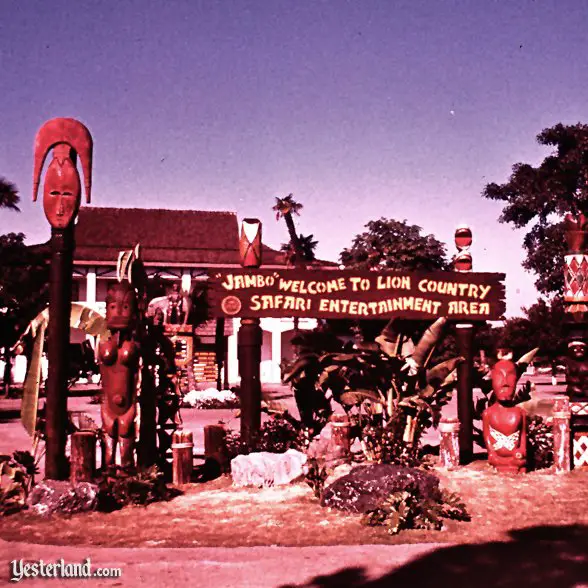
“Jambo!”
When you finish your drive-through tour of the preserve, the fun isn’t over yet. Park your car and visit the Safari Camp and Entertainment Area.
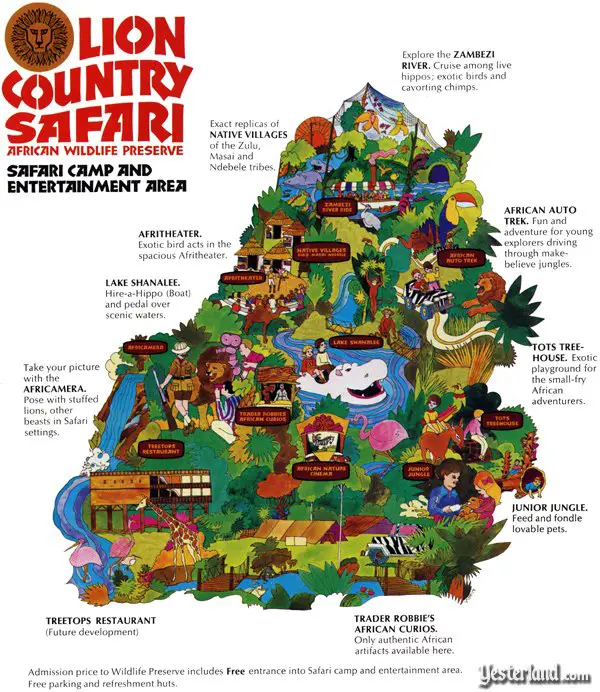
Map of Safari Camp
For a larger (1200x1400 GIF) version of this Safari Camp map, click here .
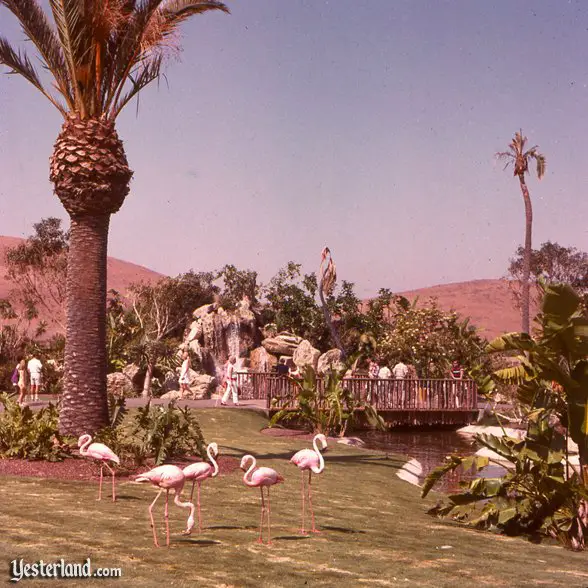
Lion Country Flamingos
Take a Zambezi River Cruise (adults 75 cents, children 50 cents)—the animals along the river are real, unlike those at the Jungle Cruise in that park in Anaheim.
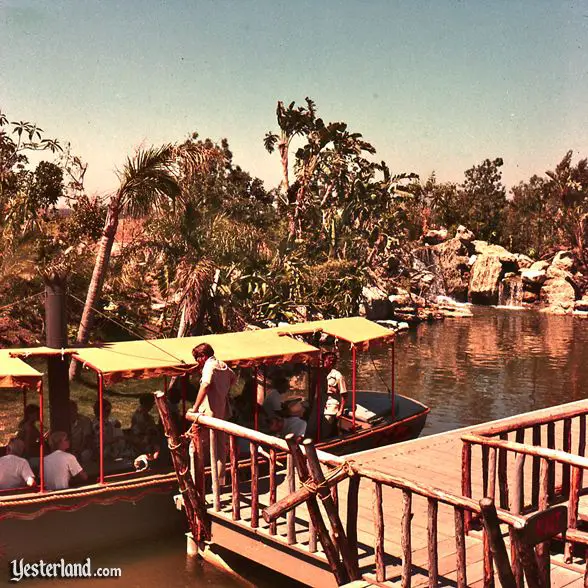
Zambezi River Cruise
California’s Lion Country Safari entertained visitors from 1970 to 1984.
On June 16, 1970, Lion Country Safari in Irvine opened to the public. The location in Southern California had a lot going for it—a great climate, a large local population, and a significant tourist base. But Lion Country Safari had stiff competition from Disneyland, Knott’s Berry Farm, and the beach.
Lion Country Safari was given a big boost by an unlikely star attraction. An elderly, nearly toothless lion named Frasier came from a Mexican circus in February 1971. The old cat’s tongue dangled from one side of his mouth, and he had trouble walking. He may not have been much to look at as far as we humans were concerned, but the lionesses saw him differently. There was a population boom of lion cubs at the park. Frasier’s sorry visage adorned tee-shirts and other park souvenirs. Frasier sired 35 cubs until his death in June 1972 at 17-20 years of age, equivalent to a human age of 85-100 years. Frasier even inspired a 1973 feature movie, Frasier the Sensuous Lion , rated PG.
In 1981, Irvine Meadows Amphitheater was added to Lion Country Safari. It was Verizon Wireless Amphitheater from 2000 to 2014. Then it reverted to its original name, before closing permanently in 2016.
On October 27, 1984, in the Los Angeles Times , staff writer Bruce Horowitz wrote about the end of the drive-through safari at Lion Country Safari:
The roar of Lion Country Safari may soon be replaced by a gurgle.
Park officials announced Thursday that they intend to phase out the 100-acre animal preserve at the struggling tourist attraction and replace a portion of it with a major water-theme amusement park.
“This land is so valuable that it no longer makes sense to have these animals occupying 100 choice acres,” said Harry Shuster, president of Lion Country Safari Inc. Over the next three months, the park plans to begin converting operations and selling its estimated 300 “wild” animals—valued at more than $200,000—to other animal parks and zoos nationwide, Shuster added.
When the lions and tigers are gone, the only remaining animals at the park will be tame ones in its petting zoo and exotic birds. Nevertheless, Shuster stressed, the park will retain the name Lion Country Safari. “Why not?” he asked. “Magic Mountain doesn’t have any magic nor is it on a mountain. And Knott’s Berry Farm hasn’t been a real farm for many years.
In November 1984, after more than 14 years in business, Lion Country Safari closed permanently. In 1986, part of the former Safari Camp became Wild Rivers Waterpark.
Surprisingly, the “so valuable” land that was once the drive-through safari remained undeveloped for decades.
The water park operated until September 2011. It’s now the site of Los Olivos, the largest apartment complex in Orange County, with 1,750 units. More apartments are planned for the site of the amphitheater when its lease runs out in 2017.
The Lion Country Safari name has long been erased. Moulton Parkway adjacent to the site is now called Irvine Center Drive. (It’s still Moulton Parkway after Lake Forest Drive.)
Yes, Lion Country Safari is long gone—but you can still visit Lion Country Safari. It doesn’t require a time machine.
That’s because the original (1967) Lion Country in Loxahatchee, Florida, is still open for business.
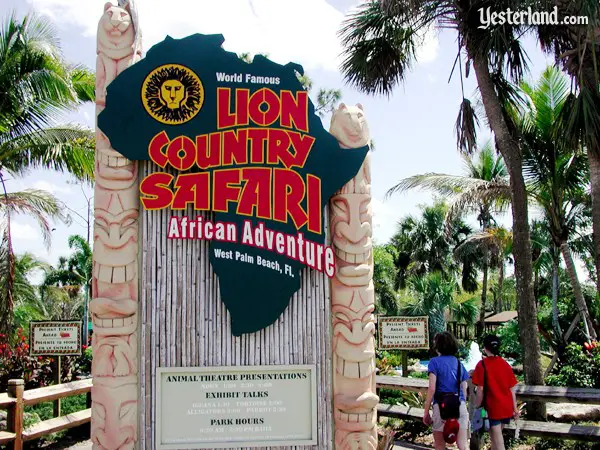
There’s still a Lion Country Safari near West Palm Beach, Florida.
Over 900 animals live at the Florida park. The four-decade-old attraction has aged gracefully. In recent years, the owners have upgraded the facilities with new features such as a giraffe feeding station, a ferris wheel, and a children’s water-play area, Safari Splash.

Cars and animals still the share the road in Florida.
There’s a four-mile drive-through preserve which provides great views of many different species. Guests are lent a CD or cassette for commentary through the car’s stereo. The lions are now fenced in. Chimpanzees live on islands. The elephants, who had long ago been moved into an elephant enclosure, were removed from Lion Country Safari in 2006; they are now at facilities that provide better social and physical environments for them. (Lion Country Safari’s Bulwagi the elephant was at Disney’s Animal Kingdom for four years before moving to the Birmingham Zoo in December 2010.) But there are still plenty of species wandering around in surprisingly large herds.
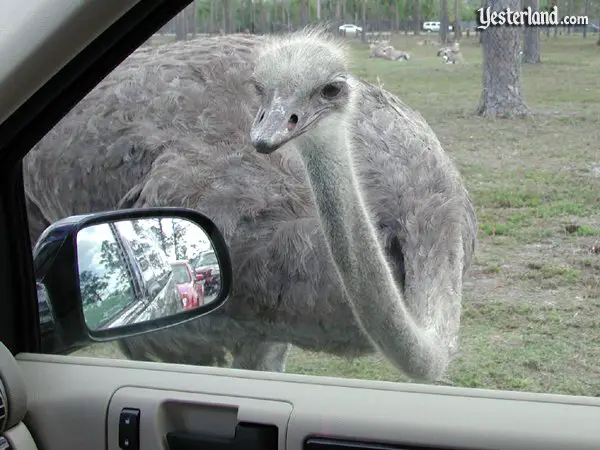
Ostriches seem to enjoy seeing their reflections in car windows.
The Safari World area provides animal exhibits, demonstrations, and rides (including rather Dumbo-esque flying elephants). After visiting Safari World, guests are welcome to drive through the preserve again at no additional charge.
It’s worth visiting Florida’s Lion Country Safari if you like animals and you’re in the area. Don’t expect the spectacular art direction of Disney’s Animal Kingdom. (It doesn’t cost as much for admission either.) This is a lovely, old-fashioned Florida attraction for guests of all ages.
© 2007-2020 Werner Weiss — Disclaimers, Copyright, and Trademarks
Updated January 5, 2020
- Scanned image of lions on road at Lion Country Safari, Irvine, California, from a Lion Country Safari brochure circa 1971. Included here for historical illustration.
- Scanned cover of Lion Country Safari brochure circa 1971. Included here for historical illustration.
- Photo of Lion Country Safari sign: from the collection of Richard Harris.
- Scan of Lion Country Safari exchange ticket: from the collection of Richard Harris.
- Photo of Lion Country Safari guard tower and giraffes: from the collection of Richard Harris.
- Scanned image of rhinos and elephants at Lion Country Safari, Irvine, California, from a Lion Country Safari brochure circa 1971. Included here for historical illustration.
- Photo of Lion Country Safari camels: from the collection of Richard Harris.
- Photo of Lion Country Safari tigers: from the collection of Richard Harris.
- Photo of Lion Country Safari giraffes on road: from the collection of Richard Harris.
- Photo of pride of lions at Lion Country Safari: courtesy of the Orange County Archives, Santa Ana, California.
- Photo of Lion Country Safari entrance to Safari Camp: from the collection of Richard Harris.
- Scanned image of map of Safari Camp and Entertainment Area at Lion Country Safari, Irvine, California, from a Lion Country Safari brochure circa 1972. Artist: T. Smith. Included here for historical illustration.
- Photo of Lion Country Safari flamingos: from the collection of Richard Harris.
- Photo of Lion Country Safari boat ride: from the collection of Richard Harris.
- Photo of Lion Country Safari (Florida) sign: 2006 by Werner Weiss.
- Photo of animals and SUV at Lion Country Safari (Florida): 2006 by Werner Weiss.
- Photo of an ostrich at Lion Country Safari (Florida): 2006 by Werner Weiss.
Richard Harris is the author Early Amusement Parks of Orange County .


GAUTENG'S MUST-SEE TOURIST DESTINATION

HEY KIDDO, WANNA WILD WITH US?
Activities for all ages.
50% PENSIONER DISCOUNT ON ALL ACTIVITIES
Charitable organisations, our youtube channel, lion & safari park.

Kiddies Horse Rides

Mountain Biking

Horseback Riding

Shandor Tour
Weather at the park.
- GAUTENG’S MUST-SEE TOURIST DESTINATION
- LITTLE RANGERS
- VOLUNTOURISM
- THINGS TO DO
- RESTAURANTS
- 5 DOME SHOPPING EXPERIENCE
- FILMING LOCATION

San Diego Zoo Wildlife Alliance Timeline
This timeline documents the 100+ year history of San Diego Zoo Wildlife Alliance, from the Zoo’s inception in 1916 after the Panama-California Exposition, to the founding of the Safari Park, and beyond.
*Pardon our dust! Links to archival sources are still being updated.

1916 · 1920 · 1930 · 1940 · 1950 · 1960 · 1970 · 1980 · 1990 · 2000 · 2010

- Drs. Harry Wegeforth , Paul Wegeforth, Fred Baker, Joseph C. Thompson and naturalist Frank Stephens hold their first organizational meeting. 10/02/1916
- One of San Diego Zoo’s first animals arrives: “Caesar” ( photo ), Kodiak bear. 11/1916. Died 9/12/1936.
- Articles of incorporation are submitted to the city, park commission, and state. They are duly executed on 12/11/1916. Dr. Wegeforth is president of the Society. ( Related article ).
- Founding of the “Junior Zoo” by W.H. Porterfield of the San Diego Sun.
- Frank Stephens serves as active director of the Zoo. Society assumes responsibility for care of all animals in Balboa Park. Zoo consists of a line of cages along Park Boulevard.
- A Grizzly bear is incorporated into the Society’s official seal. (Used until 1955 and was changed because the Grizzly became extinct in California.) 2/17/1917
- Jack Hendee appointed first superintendent. 5/11/1917
- First lion cubs born; “Faith”, “Hope”, and “Charity”. 9/17/1917
- Zoo membership is available at $5 per membership.
- Society enters legal agreement with City of San Diego transferring ownership of all animals, equipment and property to the City in return for jurisdiction over a permanent zoo site (not yet designated).
- First pair of zoo-born lion cubs are sold to the city of Seattle.
Return to Top

- Pits are built for the bears along Park Boulevard (across from Indian Village). Completed with cement floors in 1921 with funds from the City Council.
- Standard Oil Company and Combined Harvester Company donate their Exposition buildings to the Zoo.
- First organized membership campaign carried on during last months of the year.
- Zoo’s current site is approved by Board of Park Commissioners (140 acres). Nathanial Slaymaker, city planner, draws up plans. Ellen Browning Scripps donates $9,000 for fence. Formal dedication is held. Fall/1921
- First staff hired: John L. Bacon, engineer; T.N. Faulconer, secretary; Benjamin F. Tyler, legal counsel; N.E. Slaymaker, landscape architect; L.J. Gill, architect; Robert Mears, superintendent of animals; W.H. Raymenton, director of gardens; G.E. Chase, director of works.
- Lower Otay Dam is sited in the canyon north of the Reptile House . The lake that results housed aquatic birds and fresh water fish.
- Barrett Dam is constructed to create a pool for seals ; Morena Dam creates a pool for alligators.
- Architect Louis J. Gill redesigns the International Harvester Building from the Panama Exposition to serve as Reptile House and Zoo entry. Finished 4/1922.
- First curator of reptiles is Laurence M. Klauber (President of SDG&E and consultant to the Society); serves until 1931.
- First Guadalupe fur seals arrive. (First live specimens to arrive in the United States. Brought from Baja by a local fisherman.) “Mrs. Silvergate”, another Guadalupe fur seal, washes ashore at Ocean Beach and is added to the collection. 4/30/1922. Article cites early conservation efforts.
- First cage that will house an African leopard is donated by the Hotel-Men’s Association. 7/14/1922.
- Barless animal grottos (Related article).
- Zoo’s grand opening: 10 cent admission for adult non-members. Children free. Entrance is through the Reptile House (the International Harvester Building from the 1915-1916 Exposition). 1/1/1923.
- Intense development of zoo infrastructure, mission and collection. ( Related article ).
- First lion grotto constructed: “ Prince “, “Julia”, and “Sara” have a new home thanks to Ellen B. Scripps’ donation. 4/1923 (Demolished in 1999 to build Douc Langur enclosure.)
- First Asian elephants, “ Empress ” and “Queenie”, arrive from Bombay Lumber Co., via Frank Buck. Dr. Wegeforth and Harry Edwards ride the elephants from the Santa Fe Depot to the Zoo. 5/20/1923
- Frank Buck, “Bring ’em back alive”, signs a three-year contract as Zoo director. Three months later he is fired and sues the Zoo. 6/13/1923
- Tom Faulconer (Park Board secretary) accepts the Directorship of the Zoo. 6/13/1923.
- Two dromedary camels (one hump), “Turk” and “Scar”, received from the Lasky Film Corp. One Bactrian camel, “Dick”, received from Ringling Circus. 6/24/1923
- First elephant seal arrives. 7/20/1923
- Scripps’ flight cage for shore and wading birds (then the tallest in the world: 82′ high, 150′ long, 74’3″ wide at one end and 62′ at the other). Built at a cost of $15,000. Located on the south side of Primate Mesa. Dedicated 9/8/1923. ( photo )
- Mr. & Mrs. P.F. O’Rourke purchase the Nevada State Building. They pay to move it and the Standard Oil Building to Zoo grounds for use as the Children’s Education Center and Junior Zoological Society departments. Planned completion is Christmas, 1923.
- First American alligators in the Zoo, donated by General Terry.
- First Malayan sun bear on exhibit, “Sunny”. 12/02/1923
- Free elephant rides for children begin on New Year’s Day. Discontinued 2/17/1924.
- Tibetan yaks arrive. 1/20/1924
- Camels “Turk” and “Scar” give birth to “Sheik.”
- First column of Zoonooz appears in the San Diego Sun, written by W.B. France.
- Harry Wegeforth organizes other zoo directors to exchange information and animals. The organization is called the National Association of Zoological Executives. It is an affiliate of the American Institute of Park Directors and eventually becomes AAZPA in 1966 (a branch of the National Recreation and Park Association). 4/16/1924
- Zoo expands to 150 acres.
- New Bear Grotto completed; houses 5 bears—Kodiak, Black bear, Cinnamon, Himalayan and Malayan Sun bear. Funded by Ellen B. Scripps . 7/20/1924 ( Related article ).
- First Leopard Grotto completed. Home to “Sappho” and “St. Elmo”. Financed by John Burnham. 8/1924
- Double Tiger Grotto constructed. First exhibit of Sumatran tigers. Gift of Ellen B. Scripps. Ground breaking 8/28/1924, completed 11/23/1924.
- First chimpanzees “Nina” and “Bondo” arrive as gifts from Ralph Granger. 3/24/1924
- First concession stand run by Maude R. Scott on July 4th.
- First snake roundup – $100 in prizes awarded for capturing snakes for the Zoo.
- John Spreckles finances a trip to Australia for Zoo Director Tom Faulconer. Koalas “Snugglepot” and “Cuddlepie” are presented as gifts to the children of San Diego from the children of Sydney. (Marks the first foreign exchange. Other animals include: 40 kangaroos, 6 emus, wombats, dingoes, phalangers, birds of paradise, and an echidna.) 1/28/1925
- “King Tut”, a salmon-crested (Moluccan) cockatoo, arrives in San Diego 5/25/1925 via Frank Buck. Named official greeter 2/19/1951. Dies in 1990.
- Belle Benchley hired as temporary bookkeeper. 10/19/1925.
- “Sally”, a Cinnamon bear ( Ursus americanus ), is flown from Rifle, Colorado to San Diego Zoo. Touted as “First Bear to Fly.”
- First issue of Zoonooz published by the San Diego Zoo. W.B. France grants Zoo the full title to the palindrome coined for his newspaper copy. 10 cents a copy, free to members. Jan/Feb/1926
- “Sheik” the camel stars in a Hollywood movie “Beau Geste”. Also appeared in “Ben Hur”. ( photo ).
- First 2 buses (Model T made by Powell Motor Co.) donated by Miss Anne Zimmerman (retired school teacher) to transport underprivileged children to the Zoo. She also suggests giving one-hour tours on weekends and holidays for 25 cent fee. ( photo ).
- 4 large artificial rock cliffs are constructed for mountain goats on Deer Mesa.
- Flood results in first major escape (a tiger, mountain lion, and California sea lions). The enclosures cave in when heavy rains wash out the Zoo’s dams and canyon grottoes. California sea lions invade the San Diego Sun’s offices and the San Diego Police station. 4/25/1926
- Zoo received special appropriation from the City.
- P.F. O’Rourke resigns from Board of Directors. Denies gift of building to the Society and incorporates his own institution. (Related article).
- $50,000 donated by Ellen B. Scripps for research hospital. Building is begun. Completed in 1927.
- Second unit of Deer Paddocks finished.
- South Gate opened. Entrance fee is raised from 10 cents to 25 cents. All servicemen in uniform admitted for free.
- Hospital and Biological Research Institute designed by Louis J. Gill and funded by Ellen B. Scripps is dedicated. Dr. Abart takes over animal care from city veterinarian, Dr. Foelschow, who previously donated his services. 4/17/1927
- Board adopts operating practice used by London Zoo: Executive Secretary working under Board of Directors.
- Belle J. Benchley is appointed Executive Secretary with control of operations. July/1927. ( photo ).
- The sailing ship “Star of India” is donated by James W. Coffroth to the Zoological Society for a maritime museum and first unit of a proposed aquarium. ( Related article ).
- Second Australian expedition successfully completed.
- South Gate opened.
- Warehouse burns but all building are insured.
- Elk Lodge donates money for a large elk pasturage.
- Pools cemented.
- Large parrot cage built. Peccary pen and warthog pens built.
- S.C. Charles is hired as keeper and first trainer for sea lions. Johnny Zolezzi supplies the Zoo with sea lions for $25 each (a quarter of the average price). The Society uses this resource to financially assure the Zoo’s survival. Shows begin.
- First black forest cobra “Old Black” on exhibit; lived at Zoo for 29 years, still holds the longevity record in captivity.
- 30 Galapagos tortoises exhibited at the Zoo. 180 collected by Dr. Charles Townsend of the New York Aquarium from the south of Isla Isabela in the Galapagos Archipelago. ( photo ).
- “ Maggie ” and “ Jiggs ” (two young orangs) arrive from Asia.
- Second warehouse and implement shed built.
- Elephant pool built.
- First California condor donated to Zoo by Mr. & Mrs. Keith Spalding (bird was discovered with a crippled wing on Rancho Sespe).
- First Andean condor, “Bum”, arrives from Hazenbeck, Germany. 6/9/1929
- First Electus parrot, “Sassy Susie”, at the Society and in the U.S. ( Related article ).
- Birth of Bengal tiger triplets . 11/28/1929

- “ Queenie ” the elephant radio interview – KFSD. 11/01/1930.
- Collection expands via importing animals and successful breeding ( Related article ).
- Housing, cages and grottos expand and modernize
- Expedition to Guadalupe . ( Related article ).
- First collecting trip to the Galapagos Islands. A female and a baby fur seal are brought back. First captive birth is in 1934.
- First gorillas arrive. “ Mbongo ” and “N’gagi” captured by Martin and Osa Johnson. Although the purpose of capture was “scientific study and breeding”, both were found to be males. ($11,000 donated by Ellen Scripps Browning and Robert P. Scripps.) 10/5/1931. ( Related article ).
- Expeditions; collection expansion; diplomacy ( Related article ).
- Dr. Schroeder employed as Zoo veterinarian / pathologist (1932-1937). He serves as veterinarian for the Bronx Zoo in 1938 but returns in 1939. Second tenure: 1939-1941 . Becomes Zoo Director in 1954 .
- First Binturong, “Benny”, born in captivity. 7/01/1932.
- County Assessor taxes the Zoo $100,000 and attempts to sell animals and property at auction when Zoo defaults. With no bidders the Zoo is declared the property of the State. The State refuses to accept and City Council declares the auction illegal.
- First Mangabey birth at the Zoo.
- Galapagos penguins arrive and spend their first spring inside the Reptile House for warmth. ( Related article ). ( photo )
- Mirror pool donated by Anne Zimmerman , penguin group is displayed.
- First amphibian joins the collection, a giant marine toad. Collected by C.B. Perkins.
- City of San Diego passes a proposition that allows the Zoo to receive 2 cents from every $100 collected in property taxes.
- A family of four sloth bears arrive from Brazil. 6/25/1934
- First Baird’s tapir, “Mickey” – a female, arrives from Ecuador. 7/04/1934
- For a map of the zoo, c. 1934, click here .
- Milton Leeper hired as Zoo’s first garden supervisor.
- Pribilof fur seal arrives.
- Expidition to bring two Northern Elephant seals from Guadalupe Island, Mexico to the San Diego zoo. Research and conservation. ( Related article ).
- First recorded animal death from Coccidioidomycosis (a fungal disease) – a tropical American monkey. This is the same disease that kills Mbongo in 1942 .
- Grizzly bears born. 1/08/1936.
- First Galapagos albatross. 1/20/1936
- First Gray mangabey for the Zoo and first for the U.S.
- First Babirusa and first Sambar deer. June/1936
- Construction begun on new Reptile House (still in use) and Elephant Barn. International Harvester Building becomes a cafe.
- Wegeforth Bowl and Fern Canyon landscaping begun (WPA Projects).
- “Puddles” the hippo (born at the Brookfield Zoo 7/8/1935) arrives. First time a hippo is exhibited in a Pacific Coast zoo. 8/19/1936
- A second flight cage , originally called “the Great Eagle cage”, is built to house birds of prey on the north side of Primate Mesa. It is the world’s largest bird cage of its time. (This aviary is later expanded and converted to a walk-through tropical rain forest aviary .) Dedicated 03/07/1937
- Reptile Mesa is completed with outdoor pits, a Galapagos tortoise enclosure, land tortoise pens and pools for alligators and crocs.
- First emu hatching.
- Two giraffes arrive, “Lofty” and “Patches”.
- First zoo concessions manager hired.
- First spectacled bears received. 3/11/1938
- Zoo begins collaborative education program with San Diego schools.

- First cheetah arrives, “Bong”.
- Hippos “Rube” and “Rubie” arrive.
- Belle Benchley publishes My Life in a Man Made Jungle .
- First Bornean orangutan arrives, “Bujang”.
- First Zoo lectures, “ Caesar, the Kodiak bear “, by Commander J.C. Thompson.
- First Lesser pandas arrive, reproduce in 1941.
- First De Brazza’s guenons arrive. First offspring June/1945.
- First Zoo summer school program is begun.
- Dr. Harry Wegeforth dies at the age of 59. (1/07/1882 – 6/25/1941)
- Dr. Charles Schroeder resigns at the Zoo’s Veterinary Pathologist to become assistant Director to the Veterinary Department of Lederle Lab (4/15/1941). Returns to Zoo as Director in 1954 .
- Dr. Frank D. McKenney takes over from Dr. Charles Schroeder as Zoo’s Veterinary Pathologist. 6/1941
- WWII: Zoo plants its own vegetables in Mission Valley to save money during the war years.
- First number drawn by Selective Services belongs to a young Zoo employee, Howard Lee. The publicity given Lee’s leaving his job was carried all over the world.
- First jungle fowl turned loose in the Zoo.
- First Andean condor hatched in captivity in U.S. [First in the world in 1939 at the Royal Zoological Society in Amsterdam.] 7/08/1942
- Mbongo , one of two gorillas who arrived in 1931, dies from Coccidioides immitis, a fungal infection.
- First hippo born at the Zoo – “Rubie” gives birth to “Lotus”. 10/30/1943.
- First captive bred cobra hatches at the Zoo.
- Radio station KSDJ and the San Diego Zoo begin a series of Tuesday evening shows called “Animal Kingdom”, featuring brief and unrehearsed discussions of natural history. (Zoo participants are Jacqueline Schermerhorn, C.B. Perkins, and Ken Stott.)
- New birds at the Zoo: Paradise rifle birds, quetzals, ocellated turkeys.
- New mammals at the Zoo: Blesbuck, Greater kudu, Bennett’s wallaby, white-headed saki
- First artificial insemination of ocellated turkey in the U.S., fourteen hatched.
- First captive breeding of the Aruba Island rattlesnake.
- Giant salamander “Hon Honsaki” arrives from Japan; grows to be 5′ long.
- New birds at the Zoo: Burmeister’s cariama and a pair of crested screamers.
- Construction of new buffalo enclosure: one section for African water buffaloes and another for American bison. Old Buffalo Pastures are remodeled for moose (first time at the Zoo).
- New flamingo pool built in corner of Zoo.
- A dam is constructed across the lower drainage basin. The reservoir holds approximately 500,000 gallons of water and is used for irrigation purposes.
- Balboa Park miniature railroad opens near Zoo entrance. Half mile ride costs 9 cents for children, 15 cents for adults. 11/13/1948
- “Albert”, “Bouba”, and “Bata” arrive; first time three gorillas are raised together. 8/10/1949
- First snow fall in San Diego in 99 years; coincides with arrival of first snow leopards (one dies shortly after arrival due to a parasitic infection). Believed to be only snow leopard in captivity. 1/21/1949
- Belle Benchley begins term as AAZPA president, 1949-1950.

- First Dr. Harry Wegeforth Day, admission is free! After 1955, known as “Founder’s Day”. 10/01/1950
- Public Relations department established at the Zoo.
- First captive breeding of Northern fur seal.
- First zoo hatching of Florida sandhill crane.
- Terracing and construction of retaining wall in the Small Mammal Canyon.
- “ King Tut “, a salmon-crested cockatoo, is donated by Mrs. I.D. Putnam of La Mesa and named Official Greeter. 2/19/1951
- “Behind the Scenes at the Zoo”, KFMB weekly television program, begins airing. 9/22/1951
- First Hawaiian monk seal to enter and be exhibited in the Continental U.S. (died same year).
- Four koala arrive from Sydney (on loan to Paramount Studios for their film “Botany Bay”); later gifted to the Zoo by NSW
- First black rhinoceros “Sally” (born in Kenya 1950), arrives from East Africa.
- 10 new cages for Bird of paradise exhibit.
- First tuatara arrives from New Zealand. San Diego, Brookfield, Bronx, and London Zoos each receive one reptile. 11/02/1952
- Belle Benchley ‘s last day as managing director, retires after 26 years . Designated by City and County as “Belle J. Benchley Day”. Testimonial dinner at Balboa Park Club. 12/10/1953
- George Pournelle is hired as Curator of Mammals. Serves until his death. 9/01/1972
- Dr. Charles Schroeder (veterinarian/pathologist who began at the Zoo in 1932 ), assumes directorship and serves for 19 years until 1972 . 1/01/1954
- International Harvester Building from 1915 Exposition is torn down and replaced by a new entrance. A restaurant is on the right and administration building on the left. Turnstiles are installed. (Donald W. Campbell architect) 5/22/1954
- Mirror Pool is replaced by new dryer Flamingo Lagoon. New home to 22 American and Chilean flamingos. Formal dedication 7/28/1954.
- First captive breeding of Spectacled langurs and South American bush dogs.
- First Kiwi arrives from New Zealand (only one in the Western Hemisphere). 12/08/1954
- First two-headed snake exhibited in San Diego County, a banded C. King snake, “Dudley Duplex”.
- City Council allocates 2 additional acres of Balboa Park land for proposed Children’s Zoo. 10/18/1954.
- Zoorama, first San Diego Zoo live television show, begins weekly production. 1/09/1955
- New corporate seal is designed by L.J. Schwenkenmeyer for the Society. The Northern elephant seal replaces the California grizzly bear corporate seal (in use since 1917). 1/1955
- Tasmanian devils arrive from Sydney, Australia. 7/1955
- First formal horticulturist, Timothy Aller, is hired.
- City Parks & Recreation Department grants the zoo an additional 1.5 acres for the location of the Children’s Zoo
- First Okapi arrives, gift from Belgian government in the Congo. 11/27/1956
- A pair of proboscis monkeys are received from Indonesia, first to be successfully exhibited in the Western Hemisphere. 1/08/1956
- Zoo takes its first safari through Central and East Africa.
- Tasmanian devil grotto is dedicated. 7/15/1956
- New bus station for guided tours.
- First mud-mound nests built by flamingos
- Zoological Society is granted IUCN membership
- First captive hatching of Cassowaries at the Zoo (also first in U.S.) 4/1957
- First flamingo chick hatched
- $150,000 raised for Children’s Zoo. Design coordinator is Lloyd Ruocco, assisted by Charles Faust & Bil Noonan. Opens 6/30/1957.
- New Zoo exit breezeway and gift shop. 2/09/1957
- New animals: Emperor penguins, reticulated giraffe, Chinese alligator, flying snake, Hawaiian monk seal
- First successful captive breeding of Kea at the Zoo (also first in U.S.) 5/1958
- First Galapagos tortoise eggs (5) are discovered in their incubator. The eggs laid 2/16/1958; hatched 10/21/1958.
- Penguin Pavilion opens. 7/1958
- Scripps flight cage is transformed into a walk-through exhibit for shore and wading birds. New dimensions: 80′ wide, 95′ high, 115′ long.
- Wegeforth Bowl remodel and addition of semi-circular pool.
- Zoo receives the San Diego Zoo Convention & Tourist Bureau’s first tourism award.
- Zoo receives 4 koalas (1 male, 2 females, and 1 joey in pouch) from NSW to establish a breeding colony. Installation of sanctuary and exhibit area.
- Zoo receives two rare Kagus of New Caledonia listed in Extinct and Vanishing Birds of the World from the U.S. Navy.
- Dr. Schroeder begins term as AAZPA president.
- Clark Children’s Theater added to the Children’s Zoo.
- Toucan cage, Lath House, Turtletorium, 3-faced clock, sun dial, and stylized dual drinking fountain added to Children’s Zoo.
- Construction of combination seal pool and dining terraces.
- Conversion of Birds of paradise cages into walk-through exhibit.
- Renovation of all enclosures in Stork and Crane Canyon.

- Remodel of tortoise enclosure (5 Aldabra and 21 Galapagos).
- Remodel of Harbor seal and elephant seal pools.
- Five (5) hippos are moved from Elephant Mesa to new pools at bottom of Stork and Crane Canyon.
- Iceberg-style Polar Bear Grotto opens. First inhabitants are “Frieda”, “Hilda”, and “Olaf” from Norway. Exhibit includes diving platform and slide. 12/03/1960
- First koala birth in North America.
- First rare Bonobo arrives from Africa, “Kakowet”. (Died 8/24/1980 a few months before his 21st birthday.) 12/1960
- Zoo receives the AAZPA Edward Bean Award for first koala birth in Western Hemisphere.
- First hatching in the Western Hemisphere of a Kookaburra. 4/11/1961
- First Hawaiian geese arrive. 11/27/1961
- Catch Basin created in 1948 is converted to Waterfowl Lagoon.
- “Acoustiguide” 40-minute tape-recorded commentary is introduced. 12/23/1962
- First Okapi born at Zoo. “Baruti” is 4th Okapi born in U.S. 2/8/1962
- Formal opening of new and renovated exhibits on Ape and Bird Mesa. “Vila”, “Chuck”, “Trib” and “Yula” occupy one enclosure, “Albert”, “Bata”, and “Bouba” occupy another in the new Gorilla Grotto designed by Charles Faust. 6/08/1962.
- Zoo hosts 17th annual meeting of the International Union of Directors of Zoological Parks. 9/30/1962-10/05/1962
- Ape Grotto constructed between large flight cage for shore and wading birds and smaller enclosures for birds of prey. Renovation of cages for Gallinaceous birds and construction of 34 new small aviaries. Architect Charles Faust.
- Zoo receives 2 rare square-lipped White rhinos from the Natal Parks Game and Fish Preservation Board (only 600 individuals remain). 9/08/1962
- First Siberian tigers arrive. 9/11/1962
- Giraffe enclosure (moated parabola with a 1,600 sq.ft. building and two exhibit yards) is completed on Horn & Hoof Mesa. Architect Homer Delawie; Contractors Callahan Brothers. 12/1962
- “Lasai”, an Indian rhinoceros, arrives at the Zoo.
- First Gila monster conceived and hatched in captivity. Received Bean Award. 11/1963.
- Edward H. Bean Award for Galapagos tortoise births.
- Conversion of all exhibits on Large Mammal Mesa to moated enclosures for elephants and rhinos. New elephant house.
- Zoo receives a pair of Komodo dragons from Surabaja, Java. 8/14/1963
- The Zoological Society and the Malagasy government establish a Lemur conservation program at the Zoo.
- Zoo receives AAZPA Bean Award for hatching and rearing of rhinoceros iguana.
- Hummingbird Aviary opens. Designed by Charles Faust. 10/2/1964
- More than 50 construction projects completed: Tapir enclosure, incubator room in Bird Yard, Okapi enclosure extension, Orang and Chimp Grotto, Kiwi exhibit, renovated cat cages, fences replaced by moats on Horn and Hoof Mesa and Flamingo exhibit.
- Zoo raises price to $7.50 per membership.
- Wegeforth Bowl’s “Mickey” stars in the Walt Disney movie “Sammy the Way Out Seal”.
- First Lowland gorilla “Alvila” is born, 16 years after “Albert” arrives; 7th Lowland gorilla born in captivity in the world. 6/03/1965
- First Fijian banded iguanas at the Zoo.
- First time any zoo has been awarded 3 Edward H. Bean Awards for the “Most Notable Animal Births in an American Zoo”: Reptiles (African soft-shelled tortoise, first hatching recorded in captivity), Birds (Thick-billed parrots, first recorded hatched in captivity, 09/08/1965), Mammals (first Proboscis monkey birth outside its native country of Borneo, 10/12/1965). Award presented on 10/13/1966.
- 2 moated islands with playgrounds for Gibbons and Siamangs are constructed along with 5 Baboon enclosures in Old Ape Alley.
- Zoo raises price to $10.00 per membership.
- “African Plains” exhibits are created on Horn and Hoof Mesa.
- Great Ape Grotto completed.
- “Boo Boo” (female Sun bear) is discharged from the U.S. Navy and officially takes up residence in the Children’s Zoo. 12/29/1965
- A small scale model of the Elephant Enclosure opens in Children’s Zoo. 2/17/1966.
- First Gold Elephant Seal Conservation medals are awarded at AAZPA conference in San Diego (to Jean Delacour, Edward Hallstrom and Fairfield Osborn). 2/1966
- First 2 female Przewalski’s horses arrive from Catskill Game Farm in New York. 6/1966.
- First Pygmy chimpanzee birth in the U.S. “Linette”. 8/08/1966
- 6 more Gold Elephant Seal Conservation medals awarded (Harold Coolidge, Majian Grimwood, Dr. Boonsong Lekagul, Perez Olindo, Ian Player and Peter M. Scott). Fall/1966
- Zoo hosts landmark world conference on “The Role of Zoos in International Conservation of Wild Animals”. Charles Faust designs condor pin for all participants. 10/1966
- Elmer Otto Center dedicated, Zoo’s 50th birthday. 12/02/1966
- Seven zoo keepers (Dick Sweeney, Gerald “Red” Thomas, Conrad Grayson, Dennis Melvin, Ken Willingham, Carl Pyle and Walt Bromley) begin the San Diego Zoo Keepers’ Association (which eventually becomes AAZK). 12/16/1967
- First wattled cranes arrive. 4/13/1967
- Nursery for Galapagos tortoises is formally dedicated. 4/23/1968
- First U.S. breeding of Superb bird of paradise. Born 6/24/1968; Died 11/20/1973.
- Douc langurs arrive. 6/26/1968
- Skyfari groundbreaking. 10/11/1968
- Inauguration of Skyfari aerial tram, spans approximately 1,800′ of Zoo canyons and mesas. 3/20/1969
- First Przewalski’s horse born, “Bolinda”. 4/08/1969
- New kiwi enclosure (first SDZ nocturnal exhibit) dedicated. 6/18/1969
- First year with 3 million attendance. Admission is $1.50 for adults, kids free.
- Zoo increases membership cost to $12.50.
- Society president Anderson Borthwick signs agreement with Mayor Frank Curran to establish wildlife preserve on San Diego City land. Ground breaking for development of 1,800 acres leased by the San Diego Zoo for development of a “natural environment zoo” in San Pasqual. 5/14/1969

- Joan Embery, Children’s Zoo attendant, is announced as the second Miss “Zoofari”. 2/17/1970
- First Russian saigas arrive. 11/1970
- Wild Animal Park receives South African sable antelope (1/15/1970), greater kudu (1/13/1970), and first gemsbok (1/14/1970).
- San Diego community votes on Wild Animal Park plan. $6 million bond issue is approved by 75.9% of voters. 11/30/1970
- Dr. Schroeder lays out route of Wgasa Bush Line.
- Cable-suspended exhibit for birds of prey opens. Planned by Charles Faust (Zoo designer). 7/15/1970
- Joan Embery appears on “What’s My Line?” 10/26/1970
- Cheetah reproductive behavior research project is made possible by grant from the William H. Donner Foundation (Arlington, VA). 10 adult cheetahs purchased in Southwest Africa and 2 five-acre enclosures are constructed at the Wild Animal Park.
- 3 cheetahs born at the Zoo. 11/22/1970
- New facility is constructed at Zoo Hospital for post mortem exams. Renovation program enlarges entire hospital complex.
- Conservation medals awarded to Carl Hubbs and George Schaller.
- Zoo’s first Pygmy hippo birth. 12/20/1970
- Southern white rhinoceros arrive at the Wild Animal Park, 18 animals including 8 born at the Zoo. 2/18/1971
- Joan Embery tapes first “Tonight Show”, airs 11/05/1971 on channels 10 and 4. Includes “Carol” the elephant, orang and others.
- Conservation medals awarded to Karl Kenyon, Charles Shaw (posthumously) and Lewis W. Walker (posthumously).
- Wild Animal Park (1800 acre preserve) Opens to the public 9am, 5/10/72. 3,000 visitors on first day. Admission $1.25 for adults, free for Zoo members and children 15 years and younger. $1.50 to ride the tram. More than $10 million spent on construction. ($4 million society funds, $6 million bond issue — approved 11/3/70).
- Wild Animal Park Monorail is dedicated 02/18/72. Mayor Pete Wilson drives in the last “golden spike”. Opens to the public 5/10/72.
- First and only Blue bear in captivity (a color morph of the American black bear) acquired by a zoo expedition to Alaska.
- Dr. Schroeder retires as Director of Zoo. Began tenure in 1954 . 5/1972
- Dr. Donald J. Kinter assumes directorship. 8/16/1972 (Resigns under pressure 2/12/1973).
- First North African ground hornbill hatched at Wild Animal Park, receives Bean Award.
- First White rhino calf born at the Wild Animal Park, “Zibulo”. 10/11/1972
- Six (6) Arabian oryx (4 males, 2 females) are transferred from the world herd at the Phoenix Zoo to the Wild Animal PArk. 11/15/1972
- Conservation medals awarded to Philip L. Boyd and Mervyn Cowie.
- Dr. Schroeder testimonial dinner held. 1/10/1973
- Dr. Donald J. Kinter resigns as director 2/12/1973. Charles Bieler, Dr. Kinter’s executive assistant, is appointed director. Serves 12 years until February, 1985.
- First captive hatching Red shining parakeet. 3/04/1973
- First blue-crowned lory captive hatching. 3/29/1973
- Two AAZPA Bean Awards: one to the Zoo for ruffed lemur birth and one to the Wild Animal Park for Abyssinian ground hornbill hatching. 4/22/1973
- Cascade Canyon dedicated. 5/17/1973
- First Przewalski’s horses arrive at Wild Animal Park (4 females, 1 male)
- Conservation Medals awarded to Gerald Durrell (Jersey Wildlife Preservation Trust) and Margaret Owings (Friends of the Sea Otter)
- Belle Benchley dies at age 91 (8/28/1882 – 12/17/1973)
- Society raises membership cost to $16.00.
- First Tule wapiti (18 including 8 born at the Wild Animal Park) to be returned to the wild. 12/05/1974
- First bus tour given by a female driver.
- Conservation Medal awarded to Jane Goodall and Heini Hediger (Zurich Zoo director)
- Koala Club begun for children up to 12 years. Supported by McDonalds restaurants. Membership is $2/child. 4/1974
- Society raises membership cost to $18.00.
- Kilimanjaro Hiking Trail opens at Wild Animal Park. 6/27/1974
- First Arabian oryx born at Wild Animal PArk. 6/27/1974
- Employee recognition program is begun at Zoo and Wild Animal Park. Pins showing the head of a rhinoceros are awarded.
- Bill Noonan begins the Graphic Design Department. One of the first projects is to design the “Tree of Life” insignia (all symbols described in Zoonooz 6/1976).
- CRES (Center for Reproduction of Endangered Species) is established by Dr. Kurt Benirschke and Zoo Director Charles Bieler. Dr. Benirschke assumes directorship on 1/01/1975.
- Conservation Medals awarded to Bernhard Grzimek (Frankfurt Zoo) and Roland Lindeman (Catskill Game Farm)
- First Bearded dragon born in captivity. 1/29/1976
- First bongo arrives. Summer/1976
- First annual plant and flower sale at the Wild Animal Park.
- First Black rhino born, “Nanyuki”. 10/1976
- Conservation medals awarded to Kenton C. Lint and Charles Schroeder.
- “Tropical America” opens at Wild Animal Park.
- Zoo receives 2 male and 4 female koalas as a bicentennial gift from Australian government/Lone Pine Koala. Sanctuary. New expanded exhibit is built.
- First multiple birth among San Diego Zoo’s great apes, Orang-utan twins.
- Asian elephants perform in Wild Animal Park’s first elephant show (trainer Franz Tisch).
- The Jennings Center for Zoological Medicine opens at the Zoo, adding a clinical building to the hospital.
- First birth of prehensile-tailed skinks, birth to live young. 11/30/1977
- Conservation Medals awarded to Ernst Lang (Director, Basil Zoo) and Maurice Machris (World Herd of Arabian Oryx)
- First person to adopt a zoo animal is Mayor Maureen O’Connor. 5/1978
- Orchid display cases dedicated in Fern Canyon.
- First Animal Chit Chat Show held at Wegeforth Bowl. 8/1978
- First Tahitian lorie received. San Diego Zoo has the only captive breeding program outside French Polynesia.
- Wild Animal Park sends 4 male Arabian oryx to Shaumari Reserve in Jordan. 02/17/1978
- Society raises membership cost to $25.00.
- World Conference III on breeding endangered species in captivity. 11/12/1979 – 11/16/1979
- Conservation Medals awarded to William Conway (Bronx Zoo Director), Ray C. Erickson (Patuxant Wildlife Research), and Craig C. McFarland (Wildlands Management, Costa Rica).
- The San Diego Zoo receives its first Fan palms in the form of seedlings.

- First Kicks for Critters fund raiser.
- Avian Propagation Center is established.
- First Tundra wolves in San Diego Zoo’s collection. 5/1980
- Photo caravan tours begin at the Wild Animal Park. 6/11/1980
- Male cheetah “Arusha” is born at Wildlife Safari, Oregon, on 10/30/1980. He is brought to the Zoo 3 months later and introduced to “Anna”, a golden retriever.
- Wild Animal Park supplies Arabian oryx for reintroduction program in Oman (first free-ranging population)
- Society raises membership price to $30.00 per membership.
- “Condorminium” is built at the Wild Animal Park to support condor breeding program.
- Ground breaking for HOZ (Heart of the Zoo). 2/28/1981
- California Fish & Game Commission agrees to captive-breeding program for California condors. A breeding pair is to be taken from the wild and housed at the Wild Animal Park. 7/28/1981
- First elephant born at Wild Animal Park (“Thor”, an African elephant). 8/22/1981
- First hatching of Fijian banded iguana (first brought to the Zoo in 1965). 11/05/1981
- Conservation Medals awarded to Ken Stott, former General Curator and Zoonooz editor, and Dr. Heinrich Dathe (Director, Tierpark Zoo, Berlin).
- Dr. Charles Schroeder wins the Marlin Perkins Award for Professional Excellence (first time anyone other than Marlin Perkins has won the award).
- First Indo-chinese leopard born at the San Diego Zoo. 1/30/1982
- First Mhorr gazelles are born at the Zoo and in the Western Hemisphere. Two (2) births in February and September 1982.
- CRES and UC Berkeley scientists collaborate to isolate DNA from 150-year-old Quagga skin
- Warner Administration Building is completed at the Zoo. 6/1982
- Whittier Southeast Asian exhibit complex opens (includes remodel of Rain Forest Aviary, 2 islands for Siamangs, Orang-utan enclosures and Douc langur exhibit)
- Przewalski’s horses reintroduced to Ukraine.
- Society raises membership cost to $35.00 per membership.
- Conservation Medal awarded to His Royal Highness Prince Philip, Duke of Edinburgh. 2/26/1983
- First California condor, “Sisquoc”, hatched at Zoo. Egg was laid in the wild on 2/02/1983, brought to the Zoo on 2/23/1983, and hatched 3/30/1983. Sisquoc is sent to the Wild Animal Park “Condorminium”.
- First Kiwi hatching. (First Kiwi arrived to Zoo in 1954.) 4/22/1983
- First Asiatic lion cubs born at the Wild Animal Park (a Society first). 5/04/1983
- Ronald Regan designates June as Zoo and Aquarium month.
- Orchid collection wins Winship Trophy at the San Diego County Orchid Show.
- First Worldwide Tour (trips around the world led by the Zoo) begins. 8/1983
- “A World of Animals: The San Diego Zoo and Wild Animal Park” wins an award for one of the 100 best books published on science in technology. 10/1983
- Pair of Chinese monals exhibited outside of China for the first time since 1800s.
- Australian Rain Forest begun in late 1970s by park horticulturist, James Gibbons, is dedicated at the Wild Animal Park. 9/10/1983
- Charles Bieler begins term as AAZPA president.
- First koala loaned out in Koala Loan Program to the Denver Zoo. The program has loaned to over 65 cities and 12 countries since.
- Society raises membership cost to $38.00 per membership.
- Golden monkeys sent to San Diego Zoo as “Conservation Goodwill Ambassadors” from People’s Republic of China. First to be exhibited in the Western Hemisphere.
- White tiger “Tapi” on loan from the Cincinnati Zoo. 5/1984
- First Zoo fund raiser at the Zoo, “Cats in Concert”, organized by the Ocelots. (Name is changed to “The Ritz” in 1985.) 6/1984
- Charles Bieler completes term as AAZPA president (1-year term). 9/1984
- Society raises membership cost to $40.00 per membership.
- Federal and State agencies approve bringing in the last of the remaining wild California condors into captivity. All condors now at L.A. Zoo and San Diego Wild Animal Park.
- First time a rare Poitou donkey is exhibited at the Children’s Zoo.
- Doug Myers assumes directorship. (Served almost 2 years as Wild Animal Park General Manager and 1 year as Director of Operations prior to appointment.) 2/1985
- “Wild in the City” is published.
- Village Amphitheater opens at the Wild Animal Park. 3/28/1985
- First albino koala born outside of Australia, a male named “Goolara”.
- One ton bronze sculpture of a Southern white rhino donated and displayed at the Wild Animal Park, in honor of Anderson Borthwick, former president of the Society. 4/29/1985
- First year Horticulture Department is involved in Papua New Guinea expeditions.
- 9 Bali mynahs reintroduced into native habitat.
- Orchid Greenhouse is donated by the San Diego County Orchid Society
- Conservation Medal awarded to Dr. Heinz-Georg Klos, General Director, Zoologischer Garten und Aquarium Berlin, West Germany.
- First Western tufted deer in the Western Hemisphere. 12/31/1985
- Society raises membership cost to $45.00 per membership.
- Diamond Edge Strategic Plan approved (Society’s first long-range plan).
- Zoo begins rebuilding with “Bio-climate” zone concept. First multi-species enclosure is the African rock kopje.
- First Somali wild ass born in Western Hemisphere at the Zoo.
- First time an Eastern kiang, from Beijing, is exhibited in the U.S.
- Zoo receives 4 pairs of Fijian banded iguanas from the Orchid Island Cultural Center in Fiji.
- Conservation Medal awarded to David Attenborough (British film maker and naturalist)
- Dr. Werner Heuschele succeeds Dr. Kurt Benirschke as director of CRES.
- Last California condor known to be living in the wild is brought into captivity. “AC9” is taken to the Wild Animal Park. Only 27 condors exist. 4/19/1987
- Golden monkeys arrive for a 2-year stay from China. 4/20/1987
- Bonsai Pavilion opens. 5/09/1987
- First time Giant pandas arrive, “Basi” and “Yuan Yuan”, on loan from China. Opening ceremonies on 7/27/1987.
- Jarrett Meeker Foundation created in memory of Jarrett Meeker to support educational goals and opportunities for children at the San Diego Zoo.
- Internal Conservation Committee is established.
- New “Wild About Holidays” program and “Festival of Lights” begins at the Wild Animal Park.
- First fertile California condor egg laid in captivity on 3/03/1988. Hatches 4/29/1988.
- Bean Award presented to Zoo, Wild Animal Park, and L.A. Zoo for condor breeding.
- AZA Exhibit Award and Education Award for East African Rock Kopje interpretive program.
- Tiger River opens (Kroc Family Tropical Rain Forest Exhibit). 3/26/1988
- Reintroduction program for Addax (Desert antelope) begins. 3/1988
- Special Species Programs begin, sponsored by Education Department.
- PCR (Polymerase chain reaction) first used by CRES scientists to amplify DNA.
- San Diego Reader article about “Dunda” the elephant reprinted in Zoonooz. 7/1988
- Conservation Medal awarded to Russel Mittermeier.
- First koala loaned internationally to Dublin, Ireland.
- Zoo begins working with the Australia Koala Foundation (AKF).
- Papua New Guinea expedition returns with plants, birds, and a female Cuscus, “Kler”, who is exhibited in the Animal Chit Chat Show.
- Xeriscape exhibit opens at the Wild Animal Park. 4/22/1989
- Keeper Training program begins.
- First Sichuan takin born in the Western Hemisphere. 6/17/1989
- Sun Bear Forest opens. Lion-tailed macaques exhibited for first time. 6/30/1989
- Conservation Medal awarded to Norman Myers (conservationist and author).
- Andean condors (5 males) hatched in U.S. Zoo are released in Colombia.
- Arabian oryx returned to Muscat, Oman.
- Wild Animal Park receives several Northern white rhinos from the Dvur Kralove Zoo in the Czech Republic.

- First successful Mountain anoa birth at Zoo. 9/1990
- King Tut dies. 12/30/1990. ( related article ).
- Royal Lipizzaner stallions at Wild Animal Park. 5/1990
- Nativescapes Garden, Old World Succulent Garden and Water Wise Garden established at Wild Animal Park.
- Bean Award given to Zoo for Francois’ langur propagation program.
- CRES researchers produce first pheasant ever hatched from artificial insemination with frozen semen.
- AZA Award for Tiger River exhibit.
- Conservation Medal awarded to Dr. Gilbert Grosvenor (President, National Geographic).
- San Diego Zoological Society’s 75th birthday.
- Third publication of “It Began with a Roar”. 10/1991
- First King Cheetahs arrive from De Wildt, South Africa, through exchange of animals.
- Dr. Charles Robbins Schroeder dies. 7/29/1901 – 3/21/1991
- Pamela Orsi crushed by elephants. (Only animal-related death at Wild Animal Park.) 3/14/1991
- 2.5 acre Gorilla Tropics opens with troop of 6 gorillas in a 10,000′ enclosure and a new Scripps Aviary. First used of canned sound (thunder, birds, frogs). 3/23/1991
- Two-headed corn snake, “Thelma” and “Louise” arrives. 4/1991
- Rhino Conference (International Symposium on the Biology and Conservation of the Rhinoceros) takes place. Michael Werikhe, the “Rhino Man”, from Kenya, attends. 5/09/1991
- California Nativescapes opens at Wild Animal Park. 5/11/1991
- Topiary Conference and Exhibition. 5/23/1991
- 67th Annual AAZPA Conference is hosted by the Zoological Society. 9/15/1991
- Automated dinosaur exhibit, “Dinos to Rhinos”, begins at the Wild Animal Park. Created by Dinamation International Corp.
- AAZPA Significant Achievement Award for the long-term propagation of Fijian iguanas.
- First Eastern kiang born in Western Hemisphere, “Druzhba”.
- Zoo begins program to reintroduce Loggerhead shrikes to San Clemente Island.
- Conservation Medal awarded to Michael Werikhe.
- Society raises membership cost to $58 per membership.
- Wild Animal Park celebrates 20th birthday.
- First 2 California condors released into Los Angeles National Forest. 1/14/1992
- “Blanca”, a white tiger cub, is confiscated by U.S. Customs Officials and given to the San Diego Zoo. 3/1992
- First harpy eagle hatched in U.S. Only 3 breeding pairs in the world. 4/28/1992
- Naked mole-rat exhibit opens at the Zoo. 6/27/1992
- Treehouse opens (4,500 sq ft, 3 story complex). Includes cafeteria, banquet rooms, merchandising shop and “Alberts”, a fine dining restaurant. 7/2/1992
- Butterfly Encounter opens at Wild Animal Park in the Park’s new Hummingbird Pavillion. 7/4/1992
- Komodo dragon exhibited. 10/22/1992
- First black rhino, “Werikhe”, born at Zoo. 11/15/1992
- 5 Loggerhead shrikes returned to San Clemente Island through the Zoo’s efforts. 12/14/1992
- Cuban iguana research begins.
- Conservation Medal awarded to Noel Snyder (Endangered Wildlife Research Program and Wildlife Preservation Trust).
- AZA Significant Achievement Award for Gorilla Tropics.
- San Diego Zoo receives first bearded pigs in a zoo in the Western Hemisphere.
- Zoological Society receives American Museum Accreditation. Only 5 other U.S. zoos are accredited. 2/10/1993
- Zoo joins U.S. Fish & Wildlife and the Peregrine Fund to save Hawaiian crow (Alala). 11 eggs are incubated.
- Birth of first Asian elephant in San Diego, “Omar”.
- Chit Chat show closes.
- First Friends of the Garden celebration. 3/19/1993 – 3/21/1993
- Pygmy chimps at Bonobo Road (a 6,000 sq ft naturalistic exhibit for chimpanzees) and Wings of Australasia (20 new aviaries) open at the Zoo. 4/1993
- Hidden Jungle (insectarium) opens at the Wild Animal Park. 4/03/1993
- Zoo begins negotiations with China for a breeding loan of 2 pandas. Panda exhibit built to Chinese specifications (2,688 sq ft / $800,000). Begun 3/01/1993 but import permit is challenged by WWF and Bruce Babbitt (Secretary of the Interior) rejects request 6/1993. Appeal by the Zoo is again denied by the US Fish & Wildlife on 9/23/1993
- Fire at Park burns 800 acres in October. No animals were lost but vegetation was destroyed in off-exhibit holding pens and some areas within exhibits. 10/1993
- Conservation Medal awarded to Jared Diamond.
- AZA Significant Achievement Award for conservation of the San Clemente Island Loggerhead shrike.
- AZA conservation endowment fund award for wild canid reproductive strategies (shared with 9 recipients)
- Society increases membership cost to $62 per membership.
- First Nighttime Zoo and sleep-overs.
- Roar and Snore camping begins at Wild Animal Park. 4/15/1994
- First African open-billed stork chick bred in captivity hatches at Wild Animal Park. 6/08/1994
- Newly renovated raptor exhibit opens. 7/04/1994
- Head of Cardiothoracic Surgery at UC San Diego (Dr. Stuart Jamieson) performs open heart surgery on Karen (2-year-old Sumatran orang). 8/27/1994
- Lorikeet Landing and Kangaroo Encounter (Wild Animal Park interactive exhibits open on 5/28/94).
- First L’Houests’s guenon born in U.S. (1 male). 9/24/1994
- First successful Harpy eagle bred in North America. First chick hatches 11/09/1994 (incubated in APC). Second chick hatches 11/18/1994 but dies of unknown causes under parental care.
- Conservation medal awarded to Mark Plotkin.
- AZA Significant Achievement Award to Wild Animal Park for hornbill breeding program.
- The Hawaii Endangered Bird Conservation program is launched.
- U.S. Secretary of the Interior, Bruce Babbit, authorizes U.S. Fish and Wildlife to issue panda import permit. 1/14/1995
- “Arusha” the cheetah dies (starred in animal shows for 14 years; “Anna”, his golden retriever companion, died in February 1993). 5/05/1995
- 2 Sumatran rhinos die: “Barakas” of kidney disease (2/27/1959) and “Tanjung”, an 8-year-old male from a twisted intestine (2/27/1995). Only 3 Sumatrans remain in U.S. zoos – 1 in Los Angeles and 2 in Cincinnati.
- First Tuatara breeding colony outside of New Zealand is established with donation from the Atiawa Iwi Tribe of Arapawa, Brothers Island, New Zealand. 4/05/1995
- Hippo Beach opens. 110-foot long, 150,000 gallon pool with underwater viewing constructed on 3-acre site in Cascade Canyon. Cost $3.9 million. Exhibit also features 12 hippo sand sculptures (created by Gerry Kirk’s Sand Sculptures International from 50 tons of sand and 25 gallons of glue). A bronze hippo play sculpture by Burt Brent is also featured. 5/27/1995
- AZA Significant Achievement Award for Andean reintroduction program.
- Water Garden established in Kapanda Falls at Wild Animal Park.
- Bus department begins “Kangaroo Tours” (“hop” on and off at 8 locations in the Zoo).
- Ken Stott, former General Curator and Editor of Zoonooz, dies. 8/19/1995
- Conservation Medal awarded to Dr. Kurt Benirschke. 11/03/1995
- AZA Conservation Endowment Fund Award for Tree Kangaroo SSP Avian TB Research Project (shared with Woodland Park Zoo).
- Society increases membership cost to $68 per membership.
- First zoo to have float in Pasadena Rose Parade features hippos, 80th birthday cake, and Joan Embery.
- Zoo’s 80th birthday party, “Celebra80!”, features 6 international festivals with 7 commemorative pins distributed: Tiger, Hippo, Macaw, Polar Bear, Koala, Reindeer, Butterfly.
- New Okapi exhibit opens as part of Hippo Beach area. (Only 25 zoos in the world exhibit Okapis.) 4/07/1996
- CRES receives 6 Jamaican rock iguanas (species thought extinct but rediscovered in June, 1990). Joins 5 other U.S. zoos as off-site breeding colony.
- Mombasa Lagoon (animal habitat constructions for young children) added to the Park’s Nairobi Village. Petting Kraal was also remodeled as part of this project. 5/25/1996
- Renovation of Dryer Flamingo Lagoon. Completed 3/1996. First flamingo chick hatched in 14 years on 6/13/1996. Success is attributed to new exhibit plus 21 new birds.
- Polar Bear Plunge opens with 130,000 gallon pool maintained at 65 degrees; 5,500 sq ft play area. Four residents: “Castor”, “Bonnie”, and 15-month-old Canadian orphans, “Chinook” and “Shakari”. 6/29/1996
- A male park visitor enters the Manchurian brown bear enclosure and must be rescued by Zoo staff. He suffers a bite to the hip by a female bear.
- 26-year-old male Polar bear, “Castor”, dies from liver cancer.
- Female panda “Bai Yun” and male panda “Shi Shi” arrive from People’s Republic of China. 12 year research loan begins ($1,000,000 / year for panda conservation in China). 9/10/1996
- Conservation Medal awarded to Frank Tood (Eco Cepts International and Sea World) and Prof. Pan Wenshi (biologist and panda researcher).
- Dedication of Giant panda research station with Sen. Diane Feinstein on 10/22/1996. Grand opening to public on 11/01/1996.
- First Mum Festival at the Wild Animal Park. 11/1996
- AZA Significant Achievement Award for Hippo Beach.
- AZA Conservation Endowment Fund Award for use of assisted reproductive technology to conserve the Cinerus vulture (shared with 3 other zoos).
- Polar bears “Buzz” and “Neil” sent from the Louisville Zoo to join “Bonnie”, “Chinook” and “Shakari” in the Polar Bear Plunge. 1/20/1997
- “Alvila” (32-year-old matriarch of Gorilla Tropics) gives birth to female “Azizi” while still caring for adopted daughter “Imani”.
- First European river otter is born in U.S. (Pair received from Zurich Zoo in 1991). 1/24/1997
- Zoo receives a breeding pair of Kagus (flightless birds of New Caledonia). Only other birds exhibited are in New Caledonia and Japan.
- Conservation Medal awarded to David Western.
- 30 acre “Heart of Africa” opens at the Wild Animal Park. 5/24/1997
- The Zoo successfully breeds bearded pigs.
- 25th anniversary celebration at the Wild Animal Park.
- Entry rondavel and aviary remodeling at the Wild Animal Park.
- Society adopts new strategic plan: Journey into 2002.
- Conservation Medal awarded to E.O. Wilson. 4/24/1998
- Remodel of Gorilla Tropics for enhanced viewing.
- Zoo opens at 7:30 AM — “Morning Zoo Rise”.
- 2 white bearded manakins and 2 black-headed herons are first hatches in North America.
- Kurt Benirschke receives Marlin Perkins Award.
- Conservation Medal awarded to Dr. George Rabb (former director of Brookfield Zoo). 4/30/1999
- Ituri Forest opens. Includes 6 species: Okapis, hippos, forest buffalo, river otters, guenons, turacos, and peafowl. 5/29/1999.
- First births of Chacoan giant peccaries. 5/30/1999
- First birth of Indo-chinese tigers ( Panthera tigris corbetti ) for the Society. 6/10/1999
- Renewal of the Parker Aviary.
- The original bird of prey aviary (built in 1937) becomes the new Owens’ Rainforest Aviary (80′ x 150′ x 75′), housing more than 200 birds from Southeast Asia. The $4 million renovation has 1,000′ of linear walkways and complies with earthquake and wheelchair regulations.
- “Bai Yun” gives birth after being artificially inseminated with “Shi Shi’s” sperm — Giant panda cub “Hua Mei” is born on 8/21/1999 at 11:40 AM.
- Somali wild ass imported from Hai Bar, Israel.
- Bird Breeding Complex opens at Wild Animal Park. Largest off-exhibit center in U.S.
- “Mr. Zoo”, book commemorating Dr. Schroeder, is published by the Society.
- Online merchandising at www.shopzoo.com begins. 11/1999
- First zoo-based molecular diagnostic lab is launched by CRES Pathology Department.
- Alan Dixson succeeds Werner Heuschele as director of CRES.
- Hua Mei’s naming ceremony. 12/1/1999

- Society receives the largest grant in its 83-year history ($7.5 million) from the Beckman Foundation to build new CRES complex at the Wild Animal Park.
- Condor Ridge opens at the Wild Animal Park. 13 North American species are featured. 5/2000
- CRES hosts international conference, “Genetic Resources for the New Century”, May 7-11, 2000.
- CRES expands with addition of 12 post-doctoral fellowships.
- New exhibit for porcupines and aardwolves at the Zoo.
- Reptile quarantine facility is constructed.
- New Douc langur enclosure (originally the Lion Grotto , created in 1923) is constructed in Sun Bear Forest (2 30-foot towers, each with its own pond and plants).
- Heart of the Zoo III construction begins.
- AZA International Conservation Award for Jamaican iguana conservation and recovery program.
- AZA Conservation Endowment Fund Award for restoration of two critically endangered West Indian rock iguanas through headstarting and release (shared with Fort Worth Zoo).
- Conservation Medals awarded to Dr. Marilyn Renfree (Zoology Department, University of Melbourne) and John Aspinall (Director of Howletts and Port Lympne Zoos).
- Panda 2000 Conference (co-sponsored by WWF, China Wildlife Conservation Association, and China Association for Zoological Gardens). Oct 16-18 2000.
- Kiwi exhibit remodeled.
- 100th condor hatched at the Wild Animal Park. 3/22/2001
- 1st egg laid by a re-introduced California Condor in the wild on 3/25/2001. Pulled by USFWS and hatched on 6/22/2001. Chick returned to wild but dies 6/28/2001.
- Zoos old Monkey Yard is torn down (36 small cells) to make way for Heart of the Zoo III. Grass is planted for summer activities.
- Conservation Medal awarded to Dr. Peter Raven (Missouri Botanical Garden Director).
- Pacarana exhibit is constructed along Kiwi Trail.
- Giant panda exhibit expanded. New Panda research center opens.
- 2nd International Rhino Conference held at Wild Animal Park. 5/8 – 5/10/2001
- Paul Harter Veterinary Medical Center ($20 million / 64,000 sq ft) opens at the Wild Animal Park. 9/2001
- First successful captive breeding of Anegada iguanas (only 300 remain in British Virgin Islands).
- First Sumatran rhino born in captivity since 1989 at Cincinnati. A cooperative effort between Cincinnati, San Diego, Los Angeles and the Bronx Zoos. 9/14/2001
- Wild Animal Park Gorilla exhibit renovation.
- Four Storm stork chicks hatch at Wild Animal Park Breeding Complex.
- Jungle Bazaar I and II remodeled into Zoo Shop I and II. 5/2001
- First Chinese dholes (Alex, Ivana, and Yuri) arrive at the Wild Animal Park from the Moscow Zoo.
- 2nd annual Animal Behavior Management Conference. 2/27 – 3/2/2002
- Conservation Medals awarded to Dr. Richard H. Goodwin (botanist, professor and founder of the Nature Conservancy), Dr. Jeremy J.C. Mallinson (British Zoo Director and author) and Ulysses S. Seal (founder of ISIS, Chairman of Captive Breeding Specialist Group) in Minneapolis. 11/17/2002
- New Gharial exhibit opens on Reptile Mesa.
- Edward H. Bean Award for Sumatran rhino breeding program along with the L.A. Zoo, WCS, and Cincinnati Zoo.
- AZA North American Conservation Award for Hawai’i endangered bird conservation program.
- AZA International Conservation Award for tree kangaroo conservation program.
- Ceremonial groundbreaking to initiate construction of Heart of the Zoo III. 9/04/2002
- Three condor chicks hatch in the wild, none survive.
- Wild Animal Park’s Hunte Nairobi Pavilion opens, replacing Village Amphitheater. 01/2003
- Shi Shi returns to China. Giant panda, “Gao Gao”, arrives at the San Diego Zoo. 1/15/2003
- Gao Gao and Bai Yun mate naturally. 3/22/2003
- Bai Yun is artificially inseminated with Shi Shi’s sperm. 3/23/2003
- Dr. Arnold O. Beckman awarded the Zoological Society’s Conservation Medal for 2003. 3/28/2003
- Flamingos moved into a redesigned Flamingo Lagoon as part of the new Heart of the Zoo. 4/2003
- Orang-utan and Siamang exhibits redesigned to form new integrated multi-species exhibit, “Absolutely Apes”. Opens 5/2003.
- Frozen Zoo skin cells are used to clone “Jahava”, a healthy male Banteng (Advanced Cellular Technology partners with the Zoo). 4/01/2003
- Groundbreaking event for the new $22 million Arnold and Mabel Beckman Center for Reproduction of Endangered Species at the Wild Animal Park. 6/05/2003
- Dr. Don Lindburg receives primatologist award from the American Society of Primatologists. 8/2003
- Seven African elephants (1 male, 6 females) imported to the Wild Animal Park from the Kingdom of Swaziland, first elephant importation from the wild in 15 years. 8/2003
- Giant panda, Bai Yun, gives birth to male cub, Mei Sheng. (Gao Gao is the father.) 8/19/2003
- First condor chick (#305) fledges at Arizona’s Grand Canyon. 11/05/2003
- The world’s first genetically clone Banteng goes on display at the Zoo. 1/23/2004
- Hua Mei returns to China. 2/12/2004
- First Bornean sun bear born in North America, “Danum” (son of “Marcella” and “Dibu”). 2/17/2004
- Male elephant, “Vus’musi”, is born 6 months after his mother “Nudula” arrives at the Wild Animal Park. 2/23/2004
- California condors get new school facility. Puppet-reared chicks can be mentored by mature condors.
- Douc langurs taken off exhibit because of their sensitivity and raised behind the scenes. 4/2004
- San Diego City Council approves ZSSD Park Boulevard Promenade Plan for the North End of Balboa Park. 4/13/2004
- Society receives City’s “Recycler of the Year” award. 5/12/2004
- U.S.-born Giant panda, Hua Mei, gives birth to twins in China. 8/31/2004
- “Lion Camp”, 33,000 sq ft exhibit with 6 lions, opens at the Wild Animal Park. Old exhibit refurbished for breeding.
- Po’ouli is captured and brought to Maui Bird Conservation Center in Hawaii. Search for 2 other birds continues. 9/10/2004
- AZA Conservation Endowment Fund Award for restoration of California condor to Baja California, Mexico.
- IMLS National Award for Museum Service for educational programs.
- Conservation Medal awarded to John and Becky Moores, San Diego philanthropists. 9/06/2004
- 50,000 sq ft Arnold and Mabel Beckman Center for Reproduction of Endangered Species opens. 11/08/2004
- Po’ouli, male bird thought to be last of the species, dies. 11/26/2004
- Cells of Po’ouli are successfully cultured at CRES and stored in Frozen Zoo. 1/25/2005
- “Komaas”, a female Southern white rhino at the Wild Animal Park, sets longevity record of 42 years. Has given birth to 16 live offspring. 2/17/2005
- Cheetah Run Safari debuts Saturdays and Sundays at the Wild Animal Park. 4/02/2005
- Conservation Medal is awarded to Dr. George Archibald, co-founder of ICF (International Crane Foundation). 4/26/2005
- Monkey Trails and Forest Tales – a 3 acre, multilevel exhibit area uniting major areas of the Zoo, opens. 6/2005
- Conservation Carousel, featuring 60 rare and endangered species, opens at the Wild Animal Park.
- Bai Yun gives birth to third panda cub, “Su Lin”. 8/02/2005
- Hua Mei gives birth to her second set of twins in China. (First set born 9/2004). 8/29/2005
- Balloon Safari begins at the Wild Animal Park. 10/15/2005
- CRES joins National Zoological Park, Fossil Rim Wildlife Center, White Oak Conservation Center, and The Wilds to form CCSS (Conservation Centers for Species Survival)
- “Kasten”, the Zoo’s popular performer and South African caracal, miraculously recovers from a severe snake bite.
- First State of Endangered Species Symposium is held at Beckman Center (Topic: Bushmeat crisis). 3/30/2006
- CRES begins rescue of California mountain yellow-legged frog in August.
- Conservation medals awarded to Peregrine Fund’s Thomas Cade & Dr. William Burnham (deceased) and philanthropist Paxson Offield. 12/07/2006
- Society establishes a new foundation for key fundraising efforts. 12/28/2006
- The first “Walk on the Wild Side” takes place. The walk fundraises for conservation efforts.
- The Children’s Rainforest Art Explorer Program is established to “reach out to families experiencing devastating illness and chronic diseases” (Zoonooz Dec/2007, p. 16).
- Allison Alberts takes over as director of CRES, replacing Alan Dixson.
- Park Monorail (“Wgasa Bushline”) is replaced by “Journey into Africa” with African Express biodiesel vehicles. 3/16/2007
- First California condor (#321) flies from Baja to Anza-Borrego Desert in April. Returns after several days.
- New CRES Plant Division begins Native Seed Gene Bank in partnership with new Botanic Garden.
- San Clemente Loggerhead Shrike Program (CRES) is awarded Significant Achievement Award for North American Conservation from AZA.
- Asian Turtle Program (CRES) is co-awarded International Conservation Award from AZA. Shared with Fort Worth Zoo, Zoo Atlanta, Cleveland Zoo, and WCS.
- CEO Douglas Myers is confirmed to the National Museum and Library Services Board.
- Strategic plan developed for Society. Masterplans for Zoo and Wild Animal Park.
- Maasai from Mbirikani Group Ranch in Kenya spend 2 months at Wild Animal Park.
- CRES partners with High-Tech High School.
- Discovery Station opens at the old Monorail loading site next to the Thorntree Terrace at the Wild Animal Park.
- ZSSD Foundation holds inaugural meeting. 7/04/2007
- New Zoo bus depot opens in August.
- Bai Yun gives birth to fourth panda cub, “Zhen Zhen”. 8/03/2007
- Conservation medals awarded to Michael Soule and Rolf Benirschke.
- Great Rift Lift elevator begins operation at Wild Animal Park in January.
- Conservation Alliance with Polar Bear International begins. 2/01/2008
- Multi-year partnership begun with Al Ain Zoo and Aquarium Public Institution to assist in creation of a 2,000 acre Wildlife Park in Abu Dhabi, U.A.E. The new reserve will be called “Dowh Al Ain”.
- Formal interpretive volunteer program begins.
- The last Elephant Show is held at the Wild Animal Park in preparation for moving the Asian elephant collection to the Zoo’s new Elephant Odyssey exhibit. 4/06/2008 (Elephant Odyssey opens 5/23/2009.)
- Conservation Award is expanded to include 4 categories: Lifetime Achievement, Conservation-in-action, Conservation Advocate and Young Conservationist. Lifetime and Action Awards include monetary award of $10,000. Young Conservationist receives $500. Medals are awarded to Laurie Marker (Lifetime Achievement), Richard Louv (Conservation Advocate) and Gladys Kalema-Ziksoka (Conservation in Action).
- The Biomimicry / Bioinspiration Conference, the first of what becomes an annual event, is held by San Diego Zoo Global. 2008.
- Conservation Medals awarded to J. Michael Fay (Lifetime Achievement Award), Serge Dedina (Conservation in Action Award), Ken Goddard (Special Achievement Award) & Intel Founder Gordon Moore (Conservation Advocate Award). 2/2009
- The San Diego Zoo’s Institute for Conservation Research joins with the U.S. Fish and Wildlife Service to assume operation of the Desert Tortoise Conservation Center (DTCC) in Las Vegas, Nevada. 2/1/2009. (The DTCC took over operations of the DTCC Pet Desert Tortoise Hotline/Pickup Service on January 1, 2010.)
- Flightline, a zipline spanning two-thirds of a mile, opens at the Wild Animal Park. 4/30/2009
- A new guide map and wayfinding system is introduced at the Zoo. 5/23/2009
- 7-acre, $44.2 million, Harry & Grace Steele Elephant Odyssey opens. Includes 2.5 acre area with 137,000 gallon pool for Asian elephants, 1/2 acre Conrad Prebys Elephant Management Facility, 4 acres devoted to 30 additional species and education (California’s Fossil History). 5/23/2009
- CRES changes name to “San Diego Zoo’s Institute for Conservation Research”. 8/05/2009
- “Yun Zi”, 5th Giant panda cub, is born to Bai Yun. 8/05/2009
- Institute for Conservation Research receives 3 AZA Conservation Endowment Fund Awards: 1. Daily travel of African elephants in Botswana; 2. Genetic analyses of amphibian Chytrid fungus; 3. Reintroduction of California mountain yellow-legged frog.
- Wilderness Ridge Mule Rides begin at Wild Animal Park (2 hour tour through Coastal scrub habitat of San Pasqual Valley). Begins 8/08/2009, discontinued 12/16/2009.
- Kids Free Days expands to the Wild Animal Park with free admission for all children age 11 and younger. 10/01/20009 (In 2009, Founder’s Day was discontinued at the Zoo — first Monday in October — and Wild Animal Park — second Wednesday in May.)
- The 2009 Biomimicry Symposium (a partnership with Point Loma Nazarine University to promote sustainable business, renewable resources and biomimicry) is held in San Diego. 10/02/2009

- San Diego Zoo partners with Nature and Culture International (NCI) to protect the Cazaderos Forest Preserve through the Living Forest Carbon Offset Program.
- San Diego Zoo hosts a conference of world experts to discuss “The Future of Zoos”. 2/23-24/2010
- Conrad Prebys Polar Bear Plunge re-opens at the Zoo after a $1 million renovation. 3/26/2010
- Board of Trustees approves rebranding the organization’s three facilities as the San Diego Zoo (no change), San Diego Zoo Safari Park, and San Diego Zoo Institute for Conservation Research, under the new umbrella title San Diego Zoo Global. 6/30/2010
- Fetter Family Galapagos Tortoise Exhibit, a $1 million renovation project, opens at the Zoo. 9/16/2010
- Creepy Crawly Festival is first held at the Park. 10/23/2010
- Safari Park Elephant habitat expands to 5.5 acres 12/7/2010
- 2010 Conservation Medal awarded to Ivan Gayler, of Nature and Culture International. 2010
- San Diego Zoo Institute for Conservation Research receives the 2011 Plume Award for long-term avian propagation programs for work with critically endangered Hawaiian birds; the award was given by the Avian Scientific Advisory Group (ASAG) the AZA conference. 3/2011
- First annual Safari Park Half Marathon is held. 3/13/2011
- San Diego Zoo Safari Park Curator of Birds Michael Mace receives 2010 Endangered Species Recovery Champion Award from the U.S. Fish and Wildlife Service for the Pacific Southwest Region; the award recognizes Mace’s work with California condors and light-footed clapper rails. 3/18/2011
- Biofiltration wetlands habitat, a new tool for managing and reusing water, is unveiled at the Safari Park. 4/6/2011
- The Desert Tortoise Conservation Center relocates 36 desert tortoises to the wild near Las Vegas. 4/27/2011
- Western gorilla Kokamo gives birth to a male named Monroe, the first gorilla born at the Safari Park in 11 years; the baby is named after President Emeritus Lee Monroe. 6/17/2011
- San Diego Zoo Safari Park unveils the daily Cheetah Run, in which Park guests watch a cheetah chase a mechanical lure. 7/2/2011
- Partnering with Nature and Culture International, the San Diego Zoo Global Wildlife Conservancy assumes operation of the Cocha Cashu Biological Station in Manu National Park, Peru. 7/2011
- 2011 Conservation Medals awarded to Joan Embery and Duane Pillsbury and three Young Conservation Award winners: Luca Banks, Mason McGhee, Nathan Tallman. 8/11/2011
- Panda Trek exhibit opens to the public, featuring giant pandas, red pandas, Sichuan takins, and 8 species of bamboo in a 0.75 acre space. 8/9/2011
- San Diego Wildlife Conservancy is launched to unify and raise the profile of conservation efforts pursued by the San Diego Zoo, Safari Park, and Institute for Conservation Research. 9/19/2011
- Rodrigues flying foxes (fruit bats) debut in a newly opened bat house exhibit in the Safari Park’s Nairobi Village. 12/22/2011
- San Diego Zoo and Safari Park combined attendance for 2011 is nearly 5 million; total number of card-carrying members is 530,740. 2011
- Condors Sisquoc and Shatash become the first pair to ever be observed by the public incubating an egg on a life web camera set up in their off-exhibit condor care area at the San Diego Zoo Safari Park. 1/23/2012
- San Diego Zoo Bornean orangutan Janey celebrates her 50th birthday during the Zoo’s Discovery Days: Absolutely Apes event. 2/17/2012
- San Diego Zoo Global partners with Universidad Autonoma de Baja California school of veterinary medicine establish cross-border partnership to aid California Condor Recovery Program in Mexico. 2/22/2012
- Two critically endangered male Sumatran tigers were born at the Safari Park, marking the 24th and 25th births of the species at the Safari Park since the facility opened in 1972. 3/6/2012
- California condor chick “Saticoy” hatches for a live, worldwide audience on San Diego Zoo Global’s Condor Cam. 3/10/2012
- A conservation milestone is reached when the Keauhou Bird Conservation Center (operated by the Hawaii Endangered Bird Conservation Program, a field program of San Diego Zoo Global) hatches its 100th `alalā (Hawaiian crow), a species extinct in the wild. 5/31/2012
- Critically endangered Lord Howe Island stick insects hatch at the San Diego Zoo, marking the first time in San Diego Zoo Global History that the organization has participated in the reproduction of a critically endangered insect. 6/2012
- The San Diego Zoo’s Reptile Walk exhibit opens to the public, featuring reptiles and amphibians, including native California species. 7/4/2012
- Jungle Ropes Safari, a rope climb through trees featuring over thirty aerial challenges, debuts at the Safari Park. 7/20/2012
- New koala conservation effort is launched using whole-genome DNA technology to better understand the genetic fitness of each koala population; collaborators include University of Sydney, San Diego Zoo Global Wildlife Conservancy, and James Cook University. 7/2012
- San Diego Zoo panda Bai Yun gives birth to her 6th cub, a male named “Xiao Li Wu”; at 20 years old, Bai Yun is one of the oldest giant pandas known to give birth to a cub. 7/29/2012
- 2012 Conservation medals awarded to Edgardo Griffith and Heidi Ross from the El Valle Amphibian Conservation Center in Panama. 8/1/2012
- San Diego Zoo Global launches the San Diego Zoo Academy, an Internet-based training program for animal care staff at zoos around the world. 9/10/2012
- San Diego Zoo Global publication ZOONOOZ launches an iPad application featuring unique content and issues not available in print form. 9/13/2012
- San Diego Zoo Global is awarded Top Honors for the 2012 AZA International Conservation Award for its Scientific Approaches to Conservation of Giant Pandas and Their Habitat program. 9/21/2012
- San Diego Zoo Global and SeaWorld San Diego are awarded the 2012 AZA Significant Achievement in North American Conservation for the facilities’ Light-Footed Clapper Rail Recovery program. 9/26/2012
- Troop matriarch and 3rd oldest known living gorilla Vila celebrates her 55th birth at the Safari Park. 10/26/2012
- Groundbreaking is held for Tull Family Tiger Trail at the Safari Park, which is to be a 5-acre Sumatran tiger habitat; the $19.6 million exhibit is the Park’s largest project ever fully funded by philanthropy and the second-largest project for San Diego Zoo Global. 12/12/2012
- First documented case of a California condor chick fledged in the wild in Mexico in nearly 80 years, the result of reintroduction efforts by San Diego Zoo Global Wildlife Conservancy and conservation group COSTASALVAjE. 2/2013
- San Diego Zoo Global’s Central Africa program manager Ekwoge Enang Abwe is awarded the prestigious Whitley award (or “Green Oscar”) for his conservation efforts in Cameroon’s Ebo Forest. 5/2/2013
- Conrad Preby’s Australian Outback exhibit opens to the public at the San Diego Zoo. 5/24/2013
- The San Diego Zoo Institute for Conservation Research starts its first the Advanced Inquiry Masters Program through a partnership with Project Dragonfly at Miami University; the program offers two degrees including Master of Arts in Teaching in Biological Sciences and a Master of Arts of Zoology. 6/2013

Lion Country Safari history: Animals bit, gored and mauled visitors, staff

Fifty years ago, visitors lined up for miles for the opening day of Lion Country Safari , a drive-through wild animal park that was the country’s first cageless zoo.
In its half-century history, the park in rural Palm Beach County has been a favorite of local residents and of famous chimp researcher, Jane Goodall , who still visits once a year to study the park’s chimp population.
RELATED: Lion Country Safari sold to new owner
Lion Country Safari is also home to the largest herd of zebras outside Africa, a 93-year-old tortoise, southern white rhinos and a herd of giraffes.
Its ambassador is an elderly lady named Little Mama, a former Ice Capades performer, who, at close to 80, is the oldest living chimp in the world.
Need a break? Play the USA TODAY Daily Crossword Puzzle.
RELATED: Photos of Lion Country Safari’s wildlife
But mixing dangerous animals with humans during 50 years means accidents sometime happen.
In a half century, Lion Country Safari in Loxahatchee has had one fatality, as well as a number of maulings and bites. Most happened during the early years of the wild animal park when state and federal regulations were vastly different.
RELATED: Lion Country Safari might acquire cheetah, penguins.
In fact, the rules were so casual in the 1960s and ‘70s that visitors could arrange to cuddle with lion cubs.
Here’s a list of incidents from The Palm Beach Post archives:
August 1967: Two weeks before the park opened, a worker revived a female lion after pulling the unconscious 11-month old from a canal, where she’d fallen in. The game keeper gave the lion mouth-to-mouth resuscitation, putting his whole head in the lion’s toothy mouth.
November 1967: A mother lion mauled her rare, white cub, which was taken to Glades Central Hospital where it recovered in a baby incubator attended to by the LCS vet and the hospital’s nurses.
RELATED: Reader memories of Lion Country Safari
January 1969: Former ‘Tonight Show’ host Jack Paar, who was making a documentary at LCS, was bitten on the wrist by Jack Paar, his namesake lion.
October 1971: A 24-year-old elephant warden was hospitalized after the 8,000-pound pachyderm he was tending stepped on his head.
August 1973: Gus, the park’s 7,000 pound white, rhino trampled a worker who was injured but survived.
January 1974: In the park’s only fatality, a 4,000 pound water buffalo named Ralph trampled and gored to death the animal keeper who fed it every day. Malcolm Gallop, 60, of West Palm Beach, was attacked in front of a carload of tourists.
“It picked him up and slammed him down,” said Mrs. Robert Morton from Phenix, Va. who witnessed the attack while visiting the park with her family. “It just kept slamming him down.”
Park staff said Ralph had been acting aggressive since a calf he sired was born nine days earlier.
December 1975: Former lion tamer Emma Bates was given permission to feed the cubs she raised at her Royal Palm Beach home before she gave them to LCS. During one visit to the lions’ enclosures, she arrived with 40 pounds of raw meat in her car’s trunk. A group of lions burst out the door and one tackled Bates, gripping her head in its jaws. A nearby worker fought off the lion with a rake. Bates survived with multiple bites and broken bones.
July 1989: A chimp attacked workers trying to move a group of chimps to another island. One worker slipped and shot another worker in the abdomen with his park-issued .357 handgun.
March 1990: JoJo, a four-ton female elephant, picked up a worker with her trunk, spun him around, then gored him. The worker survived.
December 1993: A 400-pound male lion named Helmut mauled a caretaker who was hospitalized with puncture wounds, a severed jugular vein, and two collapsed lungs.
Remembering Perth's wildly popular African safari park, where lions stalked the family car
"Trespassers will be eaten."
It was the first of many grisly greetings for visitors to Bullen's African Lion Safari in the 1970s and 1980s.
More than 30 lions and cubs once roamed the open-range zoo in the outer-Perth suburb of Wanneroo which was established in 1971 as a refuge for displaced circus lions.
Wanneroo Museum historian Susan Dalgleish said the park tried to replicate an authentic African safari experience.
"You could sit in your car and the animals would come to you," she said.
"You'd have them coming right up getting on your bonnet, getting on the roof, and you're right there and you've got a lion or lioness actually right there outside your window.
"Anything that was an appendage on the car was open slather for the lions to take a bite off.
"Windscreen wipers were a favourite thing — they did go for tyres as well."
Taking lions by the tail
Ms Dalgleish said the lions were well cared for by staff and would eat at least two kilograms of meat every day.
"For all intents and purposes, the lions actually had quite a good life, albeit they were there on display but in a bigger area than just being in a circus."
In an oral history interview with the museum, the now-deceased park manager John Gilbertson admitted he had no background in caring for exotic animals before accepting the job.
"The only background I had was a domestic cat and dog at home, but when the lion park was being built I approached [park owners] Stafford and Ken Bullen and I was told to start the next day."
Mr Gilberton said many of the lions were tame.
"If you were working in the night quarters, Ferocious the lion would come and lay down alongside you and that's where he'd stay," he said.
"You had to get him by the tail and drag him out of the way."
Escaped lioness folklore
In the mid 1980s, police investigated reports of a lioness wandering through scrubland near the park.
A teenager claimed he had to stop his car on Wanneroo Road to avoid hitting the animal while it crossed the road.
Park coordinator Greg Bullen told a local newspaper at the time the large barbed-wire fences surrounding the park meant there was no chance of a lion escaping.
"A press release was issued by the park to say 'it's not one of ours, none of our lions have escaped', but that didn't actually solve where the lion came from," Ms Dalgleish said.
"So there's still all of this folklore about the lion that never was or was there ever a sighting?"
Tippi Hedren spells the end of safari
The beginning of the end for the park came in 1981 when American actress Tippi Hedren visited and told local media she was appalled at the conditions in which the lions were kept.
Then in 1982, a man stepped out of his car and walked into the lion compound wearing religious medallions and holding a cross — he was mauled to death by a pack of lions awaiting their mid-morning feed.
"You can't stop people from doing silly things," Mr Gilbertson said in his interview.
The park closed in 1988, with management citing the high cost of animal feed, expensive public liability insurance and opposition from animal rights activists.
"Even though the lions were not being mistreated, the tide was turning for that sort of a thing," Ms Dalgleish said.
The remaining lions were shot and killed. Management said it was too difficult to re-home the animals as they would not integrate with other prides.
It was the first and only time Western Australia had an open-range zoo.
In the lead-up to the 2017 state election, then-premier Colin Barnett pledged to establish an open-range zoo in the Perth hills, but the plans were scrapped after his government was defeated.
- X (formerly Twitter)
Related Stories
How a boy's adventure helped a lion escape.
Safari tourist gets shock of his life after stroking wild lion through car window
Perth Zoo's transformation from concrete jungle to leafy sanctuary
- Animal Cruelty
- Human Interest
- Tourism and Leisure Industry

- American History
- European History
- World History

Forgotten History: Lion Country Safari- Laguna Beach, CA 1970’s

In the 1970’s, Tucked into a small corner of Laguna Nigel, there was once a place where wild animals roamed and for just a few dollars, you could drive your car through the park called Lion Country Safari.
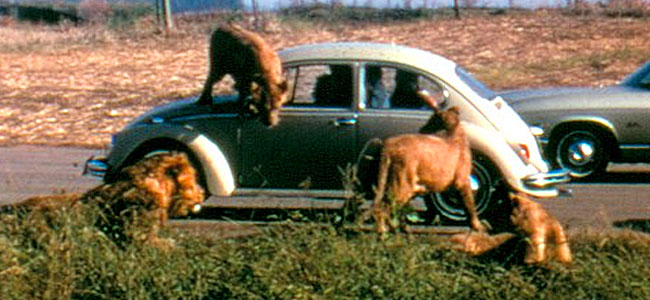
The park was famous for its funny looking lion, Frasier. The amourous lion was a legend and became a star when word spread of his virility spread. After spending most of his life in a circus, the lazy tongue-lolling Frasier fathered more than 30 cubs.

Frasier “hobbled about on weakened legs, his once-lustrous coat was scruffy and his tongue sagged from a toothless mouth,” The LA Times reported in 1977. The article from the Times added, “Lion Country bought him from a bankrupt Mexican circus in 1970, he was believed to be 18 which is the equivalent to about 80 in human years.”
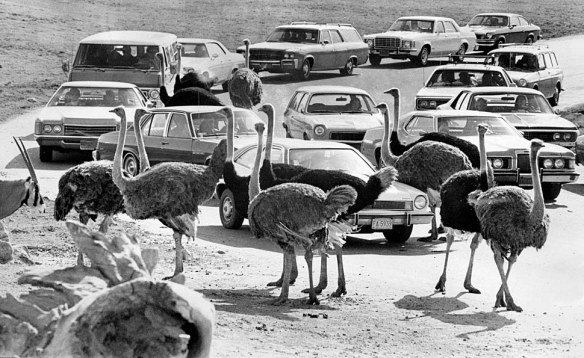
Lion Country closed in 1984. Wild Rivers Waterpark and Verizon Wireless Amphitheater now occupy part of the property, which is owned by the Irvine Co.

2024 Season
Open daily may 4 – september 15 & select dates september 18 – october 13.
Misumu Bay Wetplay is open May 18 – September 2, 2024.
We look forward to seeing you “On Safari!™”

Plan your visit
Admission & season passes, vehicle policies & accessibility, experiences on safari™, conservation & research, a full day of family fun, educational opportunities, conservation initiatives, our animals, asian elephant, european white stork, fallow deer, greater one-horned rhinoceros, lion (white), rothschild giraffe, scimitar-horned oryx, experiences for your day "on safari™", presentations, safari tour bus, pets’ corner, children’s playground, “nature boy” scenic railway, “african queen” boat cruise, misumu bay wetplay, game reserves, common questions, can i visit african lion safari.
Our 2024 season will be May 4 – October 13, 2024.
Open daily May 4 – September 15, 2024. Open select dates from September 18 – October 13, 2024.
See you soon!
Will you have washrooms available?
Washroom facilities are available at Jungle Junction, Mombasa Market Restaurant, Misumu Bay Wetplay and at the end of Tusker Trail.
What methods of payment does the park accept at retail and food service locations?
VISA, MasterCard, Interac and cash are accepted at all locations throughout the park.
Are food and beverage available?
Yes! Select food locations are open throughout the park. Please refer to the park map for seasonal locations.
Why isn’t my credit card approved online?
Please ensure that all billing information is correct and accurately reflects the address that your issuing bank/credit card company has on file. Address verification requires an exact match and slight variations may result in a declined transaction.
Do you offer rain passes?
No, we do not offer rain passes or rain checks due to inclement weather. African Lion Safari’s drive through Game Reserves operate rain or shine.
Do you have wheelchairs/wagons available for rent?
Yes, we have wheelchairs available to rent for $5.00 and wagons available to rent for $8 at our Safari Bazaar Gift Shop, located underneath Kenya Gate! With each rental, a security deposit is applied, and refunded when the rental is returned. All rentals will be cleaned and sanitized before each use.
Taigan Lions Park

Most Recent: Reviews ordered by most recent publish date in descending order.
Detailed Reviews: Reviews ordered by recency and descriptiveness of user-identified themes such as wait time, length of visit, general tips, and location information.
Taigan Lions Park - All You Need to Know BEFORE You Go (2024)

Wild Encounters
Big Lion Shows Off His Fangs in the Sunlight
Posted: June 8, 2024 | Last updated: June 8, 2024
Notorious male lion "Mr.T" of the Mapogo Coalition shows his teeth.Filmed in the Sabi Sand Wildtuin, Greater Kruger National Park, South AfricaSubscribe for more great wildlife clips: <a href="http://goo.gl/VdOHuS#Wildlife">http://goo.gl/VdOHuS#Wildlife</a> #Safari #AfricaFollow #nowfilming on social networks for LIVE photo updatesROB THE RANGER WILDLIFE VIDEOS on Social Networks:TWITTER: <a href="http://goo.gl/U8IQGfINSTAGRAM:">http://goo.gl/U8IQGfINSTAGRAM:</a> <a href="https://www.instagram.com/robtherangerBLOG:">https://www.instagram.com/robtherangerBLOG:</a> <a href="http://goo.gl/yJJ3pTFACEBOOK:">http://goo.gl/yJJ3pTFACEBOOK:</a> <a href="http://goo.gl/M8pnJhSTEEMIT:">http://goo.gl/M8pnJhSTEEMIT:</a> <a href="https://steemit.com/@robtherangerTUMBLR:">https://steemit.com/@robtherangerTUMBLR:</a> <a href="http://goo.gl/qF6sNS#YouTubeZA#YouTubeSSA#SAYouTubersPlease">http://goo.gl/qF6sNS#YouTubeZA#YouTubeSSA#SAYouTubersPlease</a> consider buying a T-shirt or hoodie to support the channel: Official Merchandise Store: <a href="https://teespring.com/stores/robtheranger">https://teespring.com/stores/robtheranger</a> Contact me via email to book a safari: [email protected] The Ranger is a proudly South African YouTuberThe purpose of the Rob The Ranger Wildlife Videos YouTube channel is to show what it is like to experience seeing wild animals on an African safari. Nature Documentaries are often highly edited to tell a story, wildlife safaris are not, and the idea here is to show the wildlife sightings the way they were seen. Safari tours in Africa are generally suitable for all ages and this channel can be considered an educational channel about incredible nature, some scenes in the nature videos may be more graphic than people are used to but this is the reality of nature and is what you would see if you were present on such a safari in person. Safaris in Kenya, South Africa, or any other African country are an unrivalled experience for anyone with a passion for nature, wildlife photography, and travel. Hopefully the animal videos on this channel can provide a glimpse into what the nature experience is like and encourage more people to take a wildlife safari one day.#africananimals #africanwildlife #africansafari #animalvideos #naturevideos #amazinganimals #worldofwildlife #africawild #africanimals #latestsightings#africanadventures #naturedocumentary #incrediblenature
More for You
Miley Cyrus Is Being Praised For Her Seriously Refreshing Comments About Not Seeing Other Artists As Her “Opponents” Or "Competition"
I ranked 12 fast-food double cheeseburgers from worst to best, and my favorite was also one of the cheapest
Cillian Murphy drama dubbed 'difficult to watch' has earned glowing reviews from critics
ABC Spent A Quarter Of A Million Dollars To Not Air All In The Family
"Mavs pretended to laugh it off, Doncic wasn't chuckling" - When Luka wasn't pleased with KP's strip club controversy
Traffic lights could be getting a fourth colour
Take a Look at This 430 Horsepower Fully Electric Flying Motorcycle
I’m a Bank Teller: 3 Times You Should Never Ask For $100 Bills at the Bank
I tried the biggest burgers at 5 fast-food chains and my favorite tasted fresh off the grill
Taylor Swift Backup Dancer Video Goes Viral
10% of travelers have had their medicines confiscated. Here's how you can avoid it.
Danny Green speaks about what happened to Westbrook on the Lakers: "He went to L.A., and he just looked like a different person"
Sleep experts say brushing your teeth right before bed is a common nighttime routine mistake — here's why
Judge Aileen Cannon tosses another curveball in the Trump cases
The 30 most popular big dog breeds in America, based on data
Carnival Cruise and Royal Caribbean make popular smoking changes
Muskox mom teaches baby how to head-butt in rare footage
Watch Pat Sajak sign off from ‘Wheel of Fortune’ for final time
"It was never a recreation for me. It was something I fell in love with" - Why Larry Bird remained in the NBA space after retiring
16 Popular Pizza Chains, Ranked Worst to Best
13 of the best things to do in Florida

Apr 3, 2024 • 10 min read
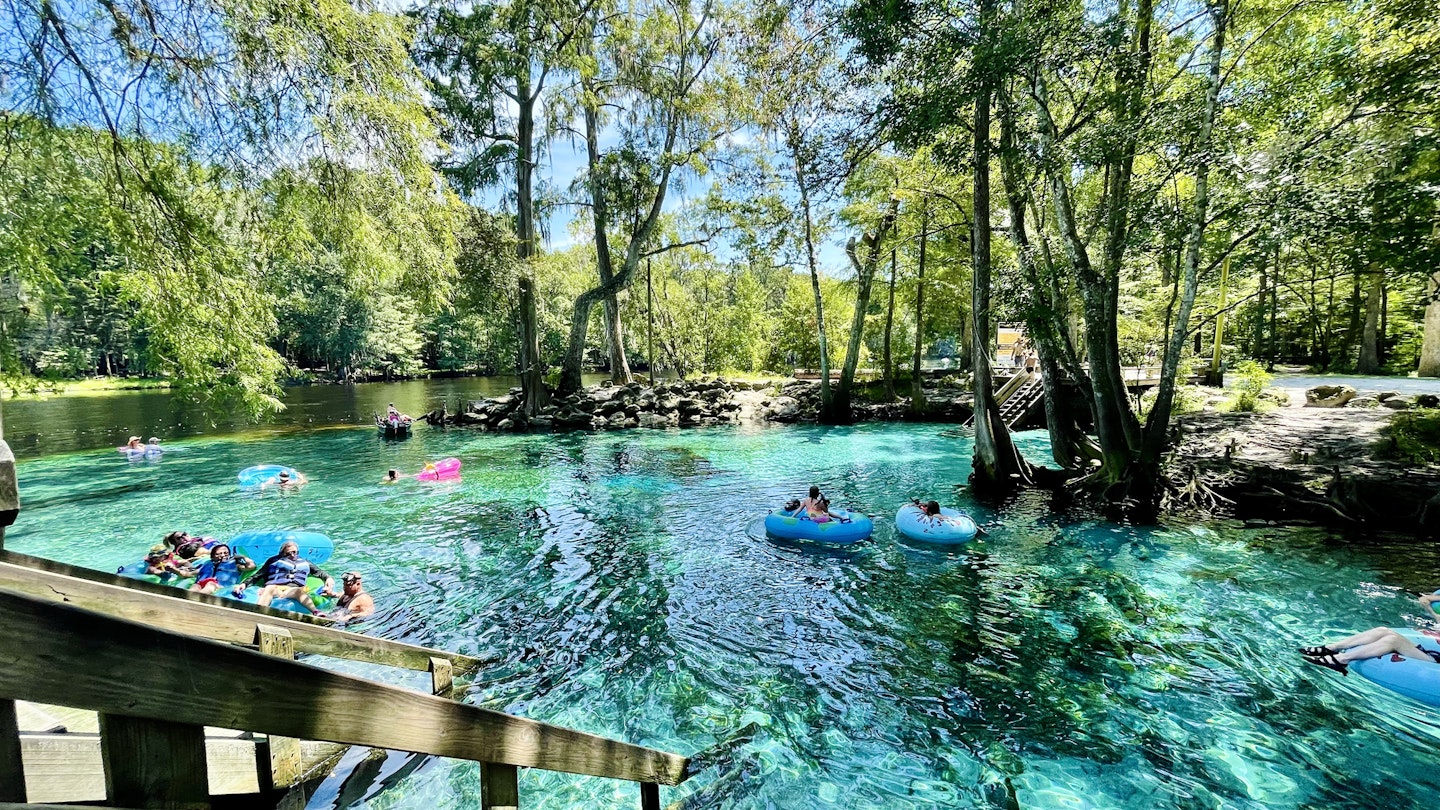
From floating in crystal-clear springs to photographing Miami icons, here are the best experiences in Florida © Erin Westgate / Getty Images
There's much more to Florida than world-class amusement parks (though it boasts some of the best ).
With an incredible blend of experiences that combine a rich, multi-cultural history, diverse cities and natural wonderlands, your must-see list will quickly become a mile long.
Whether savoring Haitian cuisine within the borders of Little Haiti in Miami or submerging yourself into the waters of a crystal-clear spring, Florida will have you planning your next trip before you even leave. Here are 14 of our favorite things to do when you get there.
Local Flavor: These are the best places to eat and drink in Miami
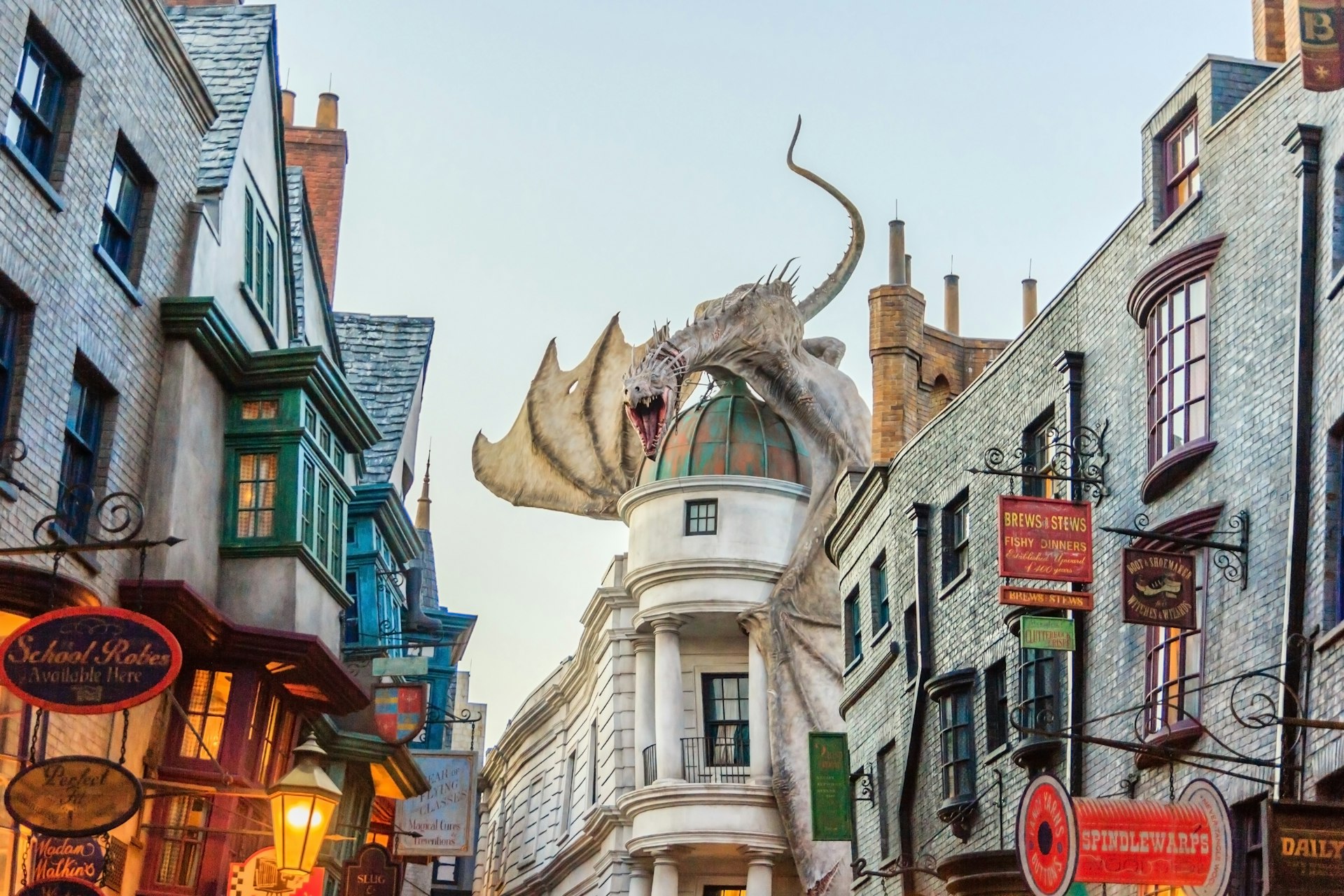
1. Spend a day at one of the many amusement parks
We figured we'd kick off this article with one of the best things Florida is known for – world-class amusement parks that promise endless excitement and unforgettable memories for people of all ages.
Everyone's heard of Disney , but with dozens of theme parks scattered around the state from Tampa to the theme park hub Orlando , there are lots to choose from, and you can't come to Florida without experiencing at least one!
Here's how to plan the ultimate weekend in Tampa
Immerse yourself in the magic of Hollywood as you embark on movie-themed, thrill-seeking rides at Universal Studios . The park is set to open its DreamWorks-themed area this summer, where guests will be able to explore attractions from the animation studio's most famous franchises like Shrek and Kung Fu Panda.
Inspire your little builder at Legoland , with its martial arts-themed area called Ninjago, plus a set of painstakingly recreated American cities in Miniland USA and a space to build your own block masterpiece. If you're traveling with little ones who are avid Peppa Pig fans, they'll squeal at the chance to run through the newly opened Peppa Pig Theme Park .
Planning tip: Check out the "Offers" page on the websites of the theme parks you visit instead of purchasing your tickets at face value. There are often promotions and discounted rates available if you extend your days at the park, which could work in your favor and help save some cash.
Add these theme parks to your Florida itinerary
2. Get a taste of Japanese culture at the Morikami Museum and Japanese Gardens
Keen on experiencing a taste of Japan without the 10+ hour flight from Florida? The Morikami Museum and Japanese Gardens in Delray Beach makes it possible by bringing Japan to South Florida.
Built to preserve Japanese culture in Florida and build cultural understanding between Japan and the US, the site contains a museum and garden that vividly showcases aspects of Japan's culture. Stroll through 16 acres of land outdoors, including a series of Japanese-inspired gardens, a bonsai collection and lakes filled with koi fish and other structures.
The museum houses over 7000 Japanese art objects and artifacts, each telling a unique story of the country's rich culture. Hungry? Swing by the on-site cafe – the Pan-Asian menu allows visitors to indulge in tasty Japanese treats.
Planning tip: On select Saturdays, Morikami demonstrates a traditional Japanese tea ceremony inside the on-site Seishin-an tea house. Consider planning your visit around one of the days when a cultural demonstration will happen.

3. Skim through the waters of the Everglades on an airboat
When many people think of Florida, the Everglades are one of the first things that come to mind. A vast expanse of shimmering wetlands and lush marshes, the Everglades is a source of unique wildlife and natural preservation.
As the largest subtropical wilderness in the United States, the national park is home to a diverse range of plant and animal species, providing habitat for various threatened and endangered species.
One of the best ways to explore the Everglades is onboard an airboat. Companies like Everglades Safari Park make it possible to easily spot alligators, turtles, birds, and many other animals that call the area home.
Looking for more great experiences? Here are our top picks in Everglades National Park
4. Embark on a safari from the comfort of your car
Your vehicle becomes a vessel of exploration at the Lion Country Safari , where you can enjoy wildlife sightings as you journey through their naturalistic habitats.
Located in West Palm Beach , Lion Country Safari allows you to drive through a 4-mile safari inhabited by herds of animals. Giraffes, alpacas, lions, zebras, and ostriches are just a few of the many animals you can expect to see roaming the land.
Beyond the drive-through adventure, the park's walking areas provide up-close encounters with animals like goats in the petting zoo area. You can even opt for a complimentary pontoon boat ride for closer views of birds and primates.
5. Have dinner on a gondola in Fort Lauderdale
Unique dining experiences are scattered throughout Florida, and now you can create more memories with a gondola dinner in the state's southern region. Run by Riverfront Gondola Tours , for 90 minutes, you and up to five guests will travel through the canals of Fort Lauderdale while enjoying your company and the views of the city.
With the option of ordering from Casa Sensei , a nearby waterfront restaurant, you can enjoy a fusion of Japanese and Latin cuisine on your ride until you return to the dock.

6. Explore popular cultural neighborhoods in Miami
Home to a plethora of unique cultures, each neighborhood in Miami pulsates with its unique rhythm, offering an immersive experience into the heart of different cultures.
In Little Havana, the air is infused with soulful melodies of salsa music, while the historic landmarks tell tales of Cuban heritage. The markets, dance studios, spiritual businesses, and statues of prominent leaders like Touissant Louverture in Little Haiti form a community that proudly highlights Haitian culture.
Stop by the Historic Overtown, one of Miami's oldest neighborhoods that served as a cultural hub for Black artists during segregation. Learn more about each neighborhood and what you can do there in our insider's guide – your next trip will be an enriching journey where you'll leave with a broadened perspective and celebrate the global cultures woven into the city's identity.
Planning tip: For a more knowledgeable tour with personal insight and the opportunity to ask questions about some of the businesses and infrastructure of the different neighborhoods, we recommend booking a tour with reputable companies like Tap Tap Tours , who can explain the history and significance of each community.
Staying for the weekend? Save this ultimate weekend itinerary for Miami's South Beach
7. Cruise on Biscayne Beach at high speeds with Thriller Miami
Miami is known for being a city with high energy, and there is perhaps no better experience to match that intensity than the Thriller Miami Speedboat . Setting sail from the docks at the Bayside Marketplace , the speedboat takes riders on a 45-minute sightseeing tour at speeds up to 40 mph.
Take in the Biscayne Bay, the City of Miami Beach, Fisher Island and finish with a tour of the Mansions on Star Island, where you'll see the homes of celebrities like Will Smith. You'll experience lots of drops, twists, and turns in between on this ride and may even get a little wet.
Planning tip : Aim to get a seat toward the front or middle of the boat to avoid getting completely soaked. The last few rows on the boat are known to leave riders more drenched than they probably planned to be.
Put in some towel time at these Florida beache s
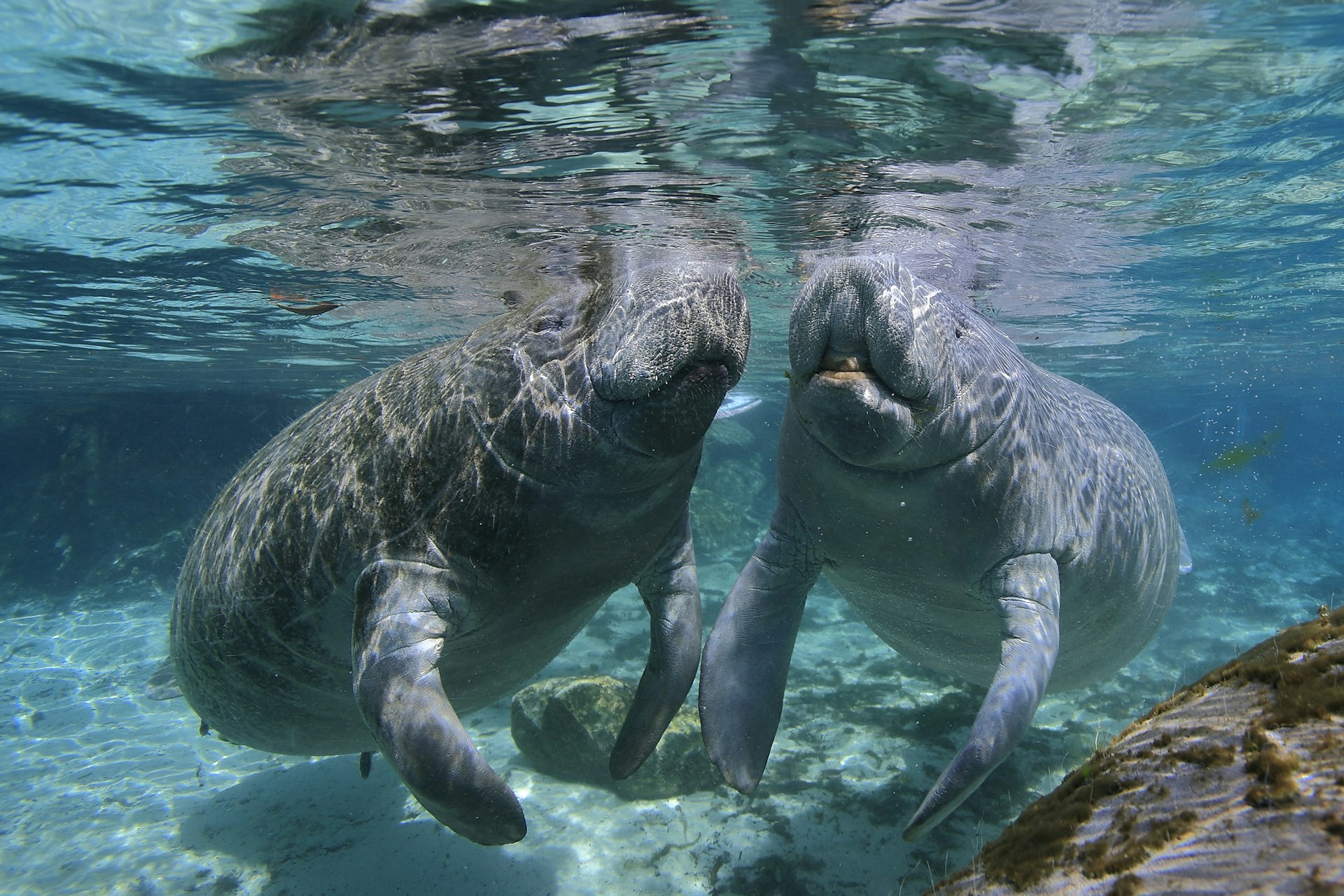
8. Spot manatees through a clear kayak in Crystal River
Manatee season in Florida runs from November to April and is the perfect time to see these majestic animals as they migrate to Florida's warm waters in the winter. While you could see manatees from an observation deck at facilities like the Manatee Lagoon , Get Up and Go Kayaking brings you straight to the water for an up-close yet respectful and ethical encounter.
On a two-hour nature tour inside a transparent kayak, you'll get to paddle your way to see manatees from a different perspective.

9. Stay in a colorful tiny home in Matlacha
Matlacha is a quaint, artsy town in Florida with a strong fishing community whose bright colorful shops can't be missed. Within Matlacha, a tiny 5-home village awaits you for a unique stay in Florida.
For about $150 a night, the homes include a full kitchenette and access to community amenities like a BBQ grill, dock, deck, and kayak launch. A stay in one of the tiny homes also gives you the chance to explore the town and visit one of the local art galleries or even go on a fishing tour .
10. Learn about Florida's Black History
Florida's Black history encompasses stories of triumph over adversity, resilience, and remarkable contributions. Thankfully, many historical sites in Florida are still in place or have been established to visit. The Mary McLeod Bethune Home in Daytona Beach is a testament to the life and legacy of educator, activist, and founder of Bethune-Cookman University, Dr. Mary McLeod Bethune.
In New Smyrna Beach, the Mary S. Harrell Black Heritage Museum houses and displays exhibits that reflect the history of race relations in Florida throughout the twentieth century. As you trace sites like these, you gain insights into various Black communities in the state and their invaluable contributions to modern-day Florida.

11. Immerse yourself in space exploration at the Kennedy Space Center
The Kennedy Space Center in Merritt Island is a space lover's dream. As you step onto the facility's grounds, you'll find yourself engulfed in the world of innovative technology and exploration.
Organized into Mission Zones, where the attractions and tours are run by chronological era, the center truly takes you through a journey of the work that has been done in the industry and what is to come. If you're lucky, you may visit during a live rocket launch and get to sit front row as yet another spacecraft launches into the air.
12. Recharge in the waters of Ginnie Springs
Nestled in the natural splendor of High Springs, Ginnie Springs emerges as a destination whose crystal-clear waters provide the perfect day trip or weekend escape. Whether you're in the mood to go tubing in the calming waters, snorkeling in the river where catfish and other critters lie, or exploring underwater caves, Ginnie Springs is truly a Florida gem.
Planning tip: As you can imagine, many people aim to experience these clear waters, so crowding is often an issue at Ginnie. To combat this, consider visiting on a weekday and avoid holidays.
13. Paint the walls at Miami's outdoor street art museum
Composed of walls elaborately painted by worldwide artists, Wynwood Walls has become a "must-see" stop when in Miami. Held primarily outdoors, the museum is an artistic oasis, with every corner unveiling creative, colorful pieces of large murals that tell their own unique story.
One of the most exciting parts of visiting Wynwood Walls is the "Street Art Experience," where you're given bottles of spray paint to contribute a piece of your artistry to the walls. The vibrancy of this museum encapsulates Miami's artistic soul, extending the spirit of creativity with you as you continue your journey through Florida.
Planning tip: If you are a student, don't forget to bring your student ID card to receive 50% off the admission fee!
Keep planning your trip to Florida
- Find out the 11 things you need to know before you visit
- Don't know where to start? These are our 9 favorite places in the Sunshine State
- Keep the kids entertained with our guide to visiting with tiny travelers in tow
- Stretch those cents and find out how to visit on a budget
This article was first published Sep 25, 2021 and updated Apr 3, 2024.
Explore related stories

National Parks
Apr 10, 2024 • 6 min read
With natural wonders, world-famous attractions and sunshine aplenty, Florida is perfect for road-tripping. Here are the best routes in the Sunshine State.

Mar 15, 2024 • 10 min read

Mar 5, 2024 • 5 min read
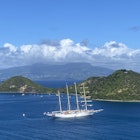
Dec 11, 2023 • 5 min read

Jul 25, 2022 • 8 min read

Mar 23, 2022 • 4 min read
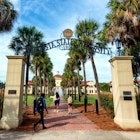
Mar 16, 2022 • 7 min read
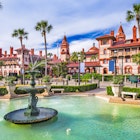
Nov 3, 2021 • 9 min read
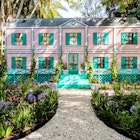
Feb 23, 2021 • 2 min read
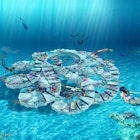
Nov 25, 2020 • 2 min read
- Copyright | Cookie policy
- Literature
- (V)IPs Zoos
- Rest of the World
- Endangered Species
- Species Classification
- (V)IPs Evolution
- Video Gallery
Select a Zoo
Reviews — zoos in europe, history description, history documentary.
During the second half of the nineteenth century the first menageries in Moscow were established as entertainment facilities. The first was founded in 1855 by two Frenchmen (names unknown), while the Kreuzberg family owned a private menagerie that opened its door to the public in 1862 . Together these animal collections formed the heart of the Moscow Zoological Garden founded by the Society for Acclimatization of Plants and Animals, which was established by professors of the Moscow State University. The initial idea for such a zoological garden came in 1857 , but it took the Society, including one of its founding fathers professor Anatoly P. Bogdanov, until 1863 to be able to buy property for the future zoo. The Zoo was opened to visitors on 13 February 1864 at the location where it still exists until this very day. On opening day 287 animals were on display, of which 134 were domestic animals, while the others were exotic specimens such as tigers, lions, jaguar, leopard and rhino.
In those days it was an unique experiment to create “a living museum outdoors,” as professor Bogdanov said, in such severe climatic conditions of central Russia. The primary purpose of the Zoological Garden according to the members of the Society was:
to collect alive specimens of higher vertebrates ( firstly — the animals of Russian fauna) for scientific observations;
to establish a collection of typical animals that could serve educational purposes, i.e. distribution of zoological knowledge among the wide public communities;
to carry out scientific experiments and observations of important animals, especially domestic animals of Russian breeds.
The Zoo was financed by the entrance fees and private donations, including contributions by members of the imperial family. In the first years the annual number of visitors grew up to ten thousands. Nevertheless, the incomes did not cover the expenses and the Moscow City Council refused to give financial support. So, the Zoo went into private hands of the Ryabinins’ family in 1874 . They transformed the Zoo into an amusement park and in three years time ruined the place. In 1878 the Zoo was run by the Society for Acclimatization of Plants and Animals again, including fund raising activities. This time the Society was able to manage the Zoo successfully, and even to buy a number of animals. But in the turmoil of the Revolution of 1905 the Zoo was severely damaged: the buildings were ruined, the library was set on fire, many animals perished. So, for the second time the Society was forced to turn over the Zoo to private owners.
Then in 1914 World War I broke out. For the Zoo this meant that in the autumn of 1914 the only building that remain to this day was transformed from the director’s premises to a hospital for wounded WWI soldiers. The WWI impact compounded Russia’s suffering from a number of economic and social problems, which resulted first in the 1917 February revolution followed by the October revolution. In the aftermath of the Great October Socialist Revolution of 1917 and the fall of the Russian Empire, the Society ceased to exist, and in 1919 the Zoological Garden was declared national property and transferred under the responsibility of the ministry of Culture of the communist Moscow parliament, the Mossovet. In 1922 it was transferred to the authority of Moscow City Council and since then it has been supported by the City Authorities. Construction work began on the Zoo grounds. The Zoological Garden premises almost doubled in size with the establishment of the ‘New’ territory on the opposite side of Bolshaya Gruzinskaya street. New exhibits, which followed the principle of Carl Hagenbeck’s bar-less enclosure design were established. One of the most interesting exhibits of the Zoo called ‘Animal Island’ still exists. It was a high stony rock surrounded by a deep water ditch that separated the visitors from bears, tigers, lions and other large predators on the ‘Island’. The total size at the time was nearly 18 hectares.
In 1926 the Zoological Garden was renamed ‘Zoological Park’. At that time the range of activities extended, the animal collection increased considerably with expeditions collecting wildlife in Central Asia, the Far East and the Caucasus. New departments were established, focussed on for instance scientific research, education, veterinary science and nutrition. In those same years Moscow Zoo was the first zoo in the world where educational activities were the main priority.
In 1924 the Zoo had established the Young Biologists Club that gathered like-minded young people that joined in real scientific research. Many of them became a Zoo employee. The Club was founded by Petr Manteifel, who also was the pioneer father of the science called ‘zoo biology’. Manteifel and his young biologists discovered a way of artificial breeding sables (Martes zibellina), which were on the verge of extinction due to man’s insatiable pursuit for its expensive fur. In the 1930 s during Stalin’s great purge many members of the Young Biologists Club were arrested accused of spreading anti-soviet propaganda and liberal-minded ideas and having contact with German colleagues at Berlin zoo, some were even executed as foreign spies. The Club was considered a non-governmental organisation beyond the direct control of the authorities, which in fact was partly true because the Club was a real democracy, with membership available to all.
Although many animals were evacuated and many of the zoo staff were called to arms at the beginning of World War II the Zoo was kept open. Of the 750 employees at autumn 1941 only 220 remained on the staff, most of them women. Getting enough food for the animals was a constant challenge, for instance carcasses of killed horse at the battlefield around Moscow were brought to the zoo. More than six million people visited the Zoo from 1941 to 1945 to enjoy the sights of animals that had remained.
At wartime the scientific work proceeded, perhaps even more intense than before or after the war. The scientific staff worked especially on development of antibiotics. But the most important mission of the Zoo during the war was to give people hope. It produced the illusion of a peaceful life until people survived through the desperation of the war with the Red Army soldiers as the most frequent visitors of the Zoo. Which were given the pleasure of watching newborn offspring even during the war.
During the soviet union period ( 1922 − 1991 ) not many highly ranked people cared about the zoo — no soviet leader had any interest in it. The city encroached on the zoo premises, while the zoo needed additional space for the ever expanding zoo population of animals. Because the breeding results were still excellent.
The Zoo lived up to the goal it had set for itself and made educational activities the main priority. Zoo staff distributed knowledge in the field of natural history and tried to raise the public awareness and concern about the necessity for wildlife conservation. The zoo assisted schoolchildren and students with studying biology, actively participated in scientific research, and actively contributed to scientific publications. So, the Zoo became one of the larger scientific institutions in Moscow. And of course it still was the favourite recreational place for Moscow citizens and those who visited the city.
As off 1974 when Igos Sosnovsky retired as director and his successor Vladimir Spitsyn took over Moscow Zoo became part of the international zoo community again. Sosnovsky as a WWII veteran hadn’t been able to brush aside the fear of repression and avoided all international contacts for some reason. Spitsyn restored all international activities from before the war and the Zoo became member of many European and International Breeding Programmes in which it exchanged its rare and endangered animals, shared experience and information.
Although already in the 1970 s improvement of all zoo facilities was needed and ideas of a new zoo in another region of Moscow were launched, nothing happened due to local economical and social problems. By the end of the 1980 s the Zoo’s condition became alarming. Facilities were deteriorating, enclosures were dilapidated and technical equipment needed to be replaced as well. And while a few improvements had been achieved — such as a partial renovation of the main entrance, the monkey house and lion house — urgent measures were still needed.
Then, in 1992 the new Moscow government made a decision to start the most ambitious reconstruction project in Moscow Zoo’s history with the first stage of the project to be completed by 1997 , when the 850 th anniversary of the City would be celebrated. Anatoly A. Andreev who had been involved in the Zoo’s design and architecture since the 1970 s headed the team of architects. The project’s renovation objectives were focussed at (a) preservation or partial renovation of the historically valuable buildings and existing pools, (b) reduction of the noise from the surrounding streets, © connection of the Old and the New territory via a footbridge, and (d) expansion of the Old territory by incorporating adjacent areas and buildings.
Besides the preservation and renovation of almost all important zoo constructions, including the ones that actually were dilapidated, many new enclosures and facilities were built. Already in 1993 the footbridge that connected the Old and New territory was completed. It allowed visitors to avoid crossing the busy B. Gruzinskaya street with its heavy traffic. In 1993 other constructions were completed as well, such as an enclosure for large birds of prey and a complex of enclosures for feline species, including leopards, Pallas’ cats and lynx. Next, the Hagenbeck-style ‘Animal Island’, one of the most remarkable exhibits in the New territory, was renovated. The historic appearance with enclosures that resembled the natural habitats of Amur tiger, striped hyena, African wild dog and Asian black bear was preserved. Later they introduced Asian lions in one of the enclosures around the large rock in the centre of the ‘island’. During the renovation they created the Exotarium, which held several aquariums, inside the rock on the second floor.
The following years many more enclosures were renovated, besides the new research and veterinarian facilities that were put into operation in 1994 . In 1996 , the main entrance itself (featuring a small artificial waterfall) was reconstructed. The same year the old, dilapidated elephant complex was demolished and a new elephant house was erected at the same spot, while the inhabitants (four African elephants and four Asian elephants) were temporarily moved to a a former tram depot that was completely renovated and specially equipped. A new children’s zoo was opened in the New territory, including a children’s theatre that organises shows with educational elements. And besides several aviaries, a pavilion for water birds was built on the shore of the large pond in the New territory.
Although in those days 4 additional hectares of space was added to the former existing 18 hectares, the Zoo still lacked space to create favourable conditions for their species to breed. And its location in the centre of Moscow didn’t contribute to the favourable breeding conditions they wanted of course. Therefore, the 200 hectares area near the city of Volokolamsk (about 100 km from Moscow) that was given to the Zoo in 1996 for the establishment of a breeding station was very much welcomed (see also Breeding Centre ).
The first major stage of the general reconstruction of the Moscow zoo represents a unique event. Not only over 50 facilities have been renovated ( 90 % of all existing facilities) and newly built, but it was achieved in such a short period of time. But maintenance and small and larger refurbishment is ongoing business in a zoo. So, i n 2002 , the Moscow City Government and the City Council allocated the necessary funds to start construction of a new pavilion for the Asian elephants. In 2003 the three elephants could move house already, and in spring 2009 , the first newborn elephant calf was welcomed.
The Moscow Zoological Park has come a long way from the small zoological garden it was to the large institution of scientific research, education, conservation and recreation it is today. And due to the dynamics of the standards used in the zoo community regarding animal health and welfare, Moscow Zoo is constantly improving its facilities, also during 2014 celebrating its 150 th anniversary.
(Source: Moscow Zoo website; Zoo with a Human Face, to the 150 th anniversary of the Moscow Zoo — a documentary by Darya Violina and Sergei Pavlovsky, 2014 ; Zoo and Aquarium History by Vernon N. Kisling, Jr., 2001 ; Wikipedia)
An account of 150 years of history of the Moscow Zoo
(A documentary by Darya Violina and Sergei Pavlovsky)
The history of Moscow Zoo shown through the perspective of the lives of the people who have been important to the Zoo’s development and continuous progress over those many years since 1864 . Thousands of photographs, hundreds of chronicles, accounts and recollections that have preserved the story that began so long ago, against all odds, and lasts uninterrupted to this day. A documentary about those who have devoted their lives to serving a noble and rewarding cause, those who have started from scratch, those who maintained that work and about those who revive the Zoo as off today.
(Source: sdpavlovskiy YouTube channel)
20 . 06 . 2014
Finally, Moscow Zoo is paid a visit. I have been looking forward to this for quite some time. It has been on my to-do list since I learnt about the large collection of feline species on display at the Zoo. So, I am here on this sunny day in June to satisfy my curiosity, in the year they celebrate the Zoo’s 150 th anniversary.
I am entering as one of the 1 , 5 million paying attendance yearly. Which is not even half of the total number of visitors a year. This is about 4 million, because there are specific categories (e.g. disabled, pensioners, children, students, etc.) for whom the admission is free.
OLD TERRITORY
I turn left after the main entrance to visit the large predator section of the Old territory. Not that only here you will find predators, but the greatest part of their predator collection is grouped in this section. I will come back to the grouping of Moscow Zoo’s animal collection later. After having walked along a fence that blocks most of the views on the work in progress at the lake I arrive at what they call here the ‘tropical cats’ section: Bengal tiger (unfortunately the genetically aberrant version — a white tiger), jaguar and cheetah. Both the tiger and the jaguar have their indoor enclosures in the same house built at the perimeter of the premises. The cheetahs have their shelter for the night and bad weather in their outdoor paddock, so that cannot be visited. The tiger and the jaguar however have interesting housing that serves the needs for both the cats and the visitors. The latter are pleased with Asian and South American (Inca) ornaments to make sure they understand the geographical origin of the species. While the walls have murals representing the species’ original habitat … Machu Pichu for the jaguar. The animals themselves have various enrichment features at their disposal, including high level observation posts, in rather small exhibits. The outdoor facilities for these two species are accessible from the indoors. It has natural vegetation, but not a lot. Likewise there are not a lot of options to shelter from extreme weather or loud crowds. Although the cats have access to several resting posts at different levels, these enclosures can do with some improvements — at least more vegetation — to make them better fit for purpose, in my opinion. The enormous exposure of the cats is also due to the fact that they use windows to separate animal from man along almost the total length of the enclosures.
When I walk the few steps to the entrance of the Bear House, which is like the jaguar and tiger indoor enclosure built at the edge of the Zoo grounds, I pass in between the Pallas’ cat exhibit and a second jaguar exhibit. The Pallas’ cat has a flat grassy area with three large trees, some shrubs and a potential pond (when filled with water) available in its outdoor enclosure. Windows all around and a wire mesh roof prevent the cat from fleeing this scenery that doesn’t resemble the cat’s original Himalyan habitat. Across the footpath there’s a jaguar enclosure that’s more interesting than the one directly neighbouring the tiger. This one has a small stream and loads of vegetation and a multilevel resting platform. Still the animal is quite exposed.
The Bear House provides a nice and secluded area where three adjacent bear enclosures houses sloth bear and spectacled bear. As a visitor you walk via a roofed corridor more or less in the dark along the enclosures having good views on the exhibit via man-sized windows. The enclosures have a dry shallow moat at the visitor’s side, but I don’t think this withhold the bears from coming close to the windows. The enclosures are small but almost completely filled with enrichment features including various platforms, a tree trunk structure, rubber hammocks and natural vegetation. Considering the design I think these enclosures offer peace and quiet for the bears, unless people start banging the windows of course.
In slightly larger enclosures they keep Amur leopard, snow leopard and cougar ( Puma concolor ). At all of these felid species enclosures the distance between the public barrier and the fence does allow contact when people lean far forward.
Further along the footpath around the corner the arctic fox and the dhole are housed in enclosures that have a similar interior design as those for the felids. Despite the fact that these species live under different natural circumstances in the wild (forest and tundra habitat respectively).
When I walk back to have a look at the large birds of prey aviary I cannot prevent myself to have a brief look at the giraffe enclosure as well. It’s obviously a relic of the past that is not fit for purpose anymore. Still they have one reticulated giraffe on display at a saddening small area. It loves to be fed by the public that doesn’t care about the warning not to feed the animals. On the other side of the building a similar pitiful situation for the single white-tailed gnu can be seen.
One of the most extraordinary group of species brought together on display can be found right after the row of predator enclosures. The maned wolf from South America has the red-necked wallaby and emu from Australia as neighbour. But also in the same area the African wild dog is on display as well as white-tailed gnu (Africa) and kiang (Asia) in the row of stables along the rim of the premises.
The raccoon exhibit is worth mentioning considering the aforementioned accident risks. It has a very typical enclosure design with electrical wire on top of windows surrounding the entire exhibit. The electrical wire is within reach of the public. So, there are numerous warning signs! But why they installed electrical wire on top of windows that are unclimbable for raccoons? To keep out the public perhaps?
In the bird house, in the far end corner from the main entrance, birds from all geographical regions are grouped together, including Humboldt penguin and African penguin. The house consists of two part with one part half empty, and has also very common species on display, such as wild turkey, common pheasant and European hedgehog. Outside this building several aviaries comprise a large array of parrot species (South America and Australia).
Proceeding with my tour around the Old territory I have a look at the Asian elephant house and its surrounding grounds. The fancy steel with blue details of the elephant house doesn’t appeal to me, but that is just a matter of taste. It is definitely the most modern exhibit in the Zoo I’ve seen yet, in style and in size, with a nice pool at the visitor’s side.
I skip the reptile house to save some time, and money too, because an additional fee complies. So I walk straight to another modern enclosure — the bar-less and moated wolf exhibit. Although it has a Hagenbeck-style design, the space available for the wolves is ridiculously small. The wolves will never be able to cross the water-filled moat and climb the wall and thus break out, still there is impressive electrical wiring in place on top of the wall. Again, probably to keep out the public.
Making my way to the footbridge that connects the Old and New territory I pass along a very old-fashioned row of enclosures built in a semicircle in front of the 16 metres high sculpture by Zurab Tsereteli called ‘Tree of Fairy Tales’, 1996 . The enclosures house several species of mustelidae (sable, European polecat, stone marten), as well as African wild cats. Then followed by several aviaries again. At this point I am really lost regarding the way they group the Zoo’s animal collection.
NEW TERRITORY
Proceeding clockwise I find the doors of the Tropical House closed for renovation. So, no butterflies for me this time. But in one of the two spacious aviaries around this house I discover several ducks, such as the mandarin duck and the black-bellied whistling duck, together with the common kestrel ( Falco tinnunculus ), though neither rare nor endangered.
Then a rather special exhibit appears, the Animal Island, which was developed in the 1920 s as one of the first Hagenbeck-style enclosures in the New territory. Although it took some renovation activities it still exists to this very day. In the centre of this moated area they have erected a fake ruined fortress, which serves as the background for the species in the surrounding exhibits. These bar-less exhibits have a more modern appearance but it isn’t necessarily an improvement for the animals. For instance the Asian black bear has a bare environment with minor enrichment available and no vegetation, but the brown bear is even worse off in a similar enclosure but next to nothing of enrichment features. The tundra wolf ( Canis lupus alba ) and the striped hyena have a little better place at their disposal, but the Asian lions have by far the best enclosure. They have several resting platforms, trees and a stream that ends in the moat. Again to save time I skip an exhibit. This time the Exotarium with its aquariums that has been created inside the ruined fortress and by the way requires an additional fee to get in.
One of the rare areas in Moscow Zoo where you find mixed-species exhibits is called ‘Fauna of the Savannah’. It has a South American section with capybara vicuna and guanaco, and — very importantly — a large pool at the disposal of the largest rodent on earth. Though absolutely not endangered, these water-loving capybaras should have access to water at all times, in my opinion. The real savannah area with African species has several enclosures. A mixed species exhibit with sable antelope and dikdik. And Grevy’s zebra together with ostrich and giraffe. Also this time there’s only one giraffe in the paddock. The location of the meerkat enclosure is well chosen, because when they sit on top of one of their hills they can watch the other animals. Although it is the largest and probably the most modern facility at the Moscow Zoo I still think it is disappointingly mediocre compared to other zoos I have seen in Europe and North America.
Before I go to the primate section I buy myself an ice cream and walk along the horse stables on the eastern edge of the New territory premises. Looking for an answer to the question “why are there horse stables at this place?” The question still waits for an answer.
At Moscow Zoo they keep both Sumatran as Bornean orangutans, which is quite unusual. The outdoors for the five individuals, including 2 young, of the Sumatran species looks impressive due to the enormously high rock face at the rear. The wall looks extra impressive because it is rather close to the viewing windows. Unfortunately, the exhibit lacks trees and vegetation other than grass while the enrichment is scant and I don’t see puzzle feeders. The Bornean orangutans have a similar outdoor enclosure, but it is suggested that olive baboons ( Papio anubis ) are on display here as well. It could be that they alternate in the same outdoor enclosure, but this is not very clear.
The western lowland gorillas also have a similar outdoor enclosure design due to which the animals are enormously exposed to the inquisitive public. Considering the number of youngsters Moscow Zoo appears to be having good results breeding orangutans and gorillas.
Indoors, all the great ape exhibits have much enrichment and jungle-like murals, but the agile gibbon has even more enrichment inside. I haven’t seen a specific outdoor enclosure for the agile gibbon but it could be possible that it alternates with the Sumatran orangutans. Only this enclosure lacks high trees or other options for the gibbon to brachiate, which is its natural behaviour in the canopy of the gibbon’s native habitat, the rainforests of southeast Asia.
The terrarium building, located behind the Primate House, is beautifully decorated with little mosaic tiles. They have the usual row of exhibits, but in this case especially the larger reptiles and tortoises (python, crocodiles, alligator, tortoise) are kept. And outside they have two giant tortoise species, the Aldabra and the Galapagos tortoise.
On my return to the exit I pass the exhibits of a few of the many predator species they have on display at Moscow Zoo. The polar bear is provided with a big heap of artificial ice, but that’s about it when it comes to enrichment, though there are some plastic drums to play with. The enclosure as such is the prototype of polar bear enclosures worldwide, rear wall of cement and large bricks, concrete floor, large and deep water-filled moat. Unfortunately, again here the annoying reflecting windows. The yellow-throated marten I do not see, and the same counts for the Eurasian otter in its large elongated outdoor exhibit with a shallow pool along the whole length. It must be great to see the submerged otters swim in this pool.
Conclusion There are several ways to group a collection of animals which can support a zoo’s educational efforts. Of course, some people just come to the zoo to be entertained, but when an individual is ready to learn some things the worst thing you can do is confuse him or her. And to be fairly honest, confusing it is. Sometimes they group the collection according their taxonomic tree, which is the case with the felids, the bird species and the primates. Then again they have decided to present the collection by geographical origin, like in the ‘Fauna of the Savannah’, or according original habitat like the mountain-dwelling tur and markhor. And at some point they just make a mess of the grouping, for instance in the area with the maned wolf, the red-necked wallaby and others. In the end it seems the Zoo just want to have on display as many species as possible, because all species that live in herds they keep them in small numbers. I do understand that it is not easy, requires tough decisions and certainly is not cheap to rearrange your entire collection, especially when it is that huge as it is here at Moscow Zoo. Anyway, further renovation is foreseen and probably some rethinking as well.
I hope that they get rid of all these windows they have at so many exhibits. For some situations it is inevitable I understand, but I sincerely hope they will return to the original Hagenbeck idea of bar-less enclosures, taking into account modern husbandry standards of course. As the position of the sun makes it sometimes hard to get even the slightest glimpse of the animals due to the reflections in the windows. And last but not least they have the tendency to have windows all around or at more than 50 percent of the perimeter of an enclosure. Most of the time leading to more exposure of the animals to the public and possible unrest.
Sumatran orangutan youngsters at Moscow Zoo
Just another day at the zoo for these orangutans ( Pongo abelii ) — nothing much exciting going on in this safe and secure environment. But wouldn’t it be nice to see them swinging and romping in the forests of Sumatra.….
Raccoons at Moscow Zoo
Raccoons are known for their habit to clean their food in the water before eating it. It seems they also want to have a clean ball before playing with it.
Breeding Centre
Information and education, zoo details, breeding farm.
The Moscow Zoo has always been trying to create the most favourable conditions for their animals to fulfil their basic needs. Not only for animal health and welfare purposes but also to breed the animals successfully. These specific breeding conditions could not be achieved due to its location in the City centre and the lack of space. In 1996 the Zoo came into possession of an area of 200 hectares near the city of Volokolamsk (about 100 km from Moscow). In this picturesque hilly area of the former quarries of the Sychovo mining factory, with streams, springs and artificial ponds better opportunities were available for breeding various — predominantly rare — species of animals.
The main goals of the Breeding Centre, besides maintaining rare and endangered species of animals, are establishing breeding pairs and groups and developing new husbandry methods. Since excessive disturbance is likely to have adverse effect on the breeding efforts, the actual Breeding Centre is not open to the public.
The construction of the Breeding Centre started in March 1996 . The first inhabitants of the Centre were birds of prey and waterfowl and they have been successfully breeding birds ever since. The collection of waterfowl has grown notably since the beginning. Apart from the numerous mallards and ruddy shelducks, the inhabitants of the ponds include pintails, pochards, tufted ducks and black geese of the genus Branta. Bewick’s swans are thriving, raising their chicks every year. Japanese, white-naped and Siberian cranes are also breeding successfully and many other species, including parrots. The breeding centre for birds of prey is continuously expanding, with Himalayan griffon vultures, golden eagles, imperial eagles, Steller’s sea eagles, and black vultures among its most prominent inhabitants. Regular breeding has also been achieved in saker falcons ( Falco cherrug ).
They keep carnivorous mammals as well at the Breeding Centre. These include endangered species such as Amur leopard, Pallas’ cat, cheetah, Amur tiger, dhole, wolverine, and yellow-throated marten. Of these species the Amur leopard is listed Critically Endangered according the IUCN Red List of Threatened Species™ , with about 45 individuals left in the wild. The Zoo’s track record says they have produced offspring from Pallas’ cat, dhole, yellow-throated marten, and Amur tiger.
For the ungulates that are kept at the Centre the environment is almost ideal. There are bactrian camels as well as kiangs, Saiga antelopes, blue sheep and vicunas. Hoofed animals originating from mountainous areas have large paddocks at their disposal that are situated on the slopes of the surrounding hills, more or less similar to their natural habitat.
Besides the more rare and endangered species the Centre also has an interesting collection of domestic hens, a horse stable and a dog-breeding centre, mainly for the breeding of Central Asian sheep dogs. Furthermore, there is a small quail farm and a poultry farm with layer hens.
Moreover a subsidiary farm in Lotoshino houses some cattle, smaller livestock, and the main herd of bactrian camels and yaks. The area of the subsidiary farm is about 51 hectares and it comprises hayfields, pastures, a sheepfold and an apiary. Most importantly it provides the Moscow Zoo with ecological feed for its animals.
The Breeding Centre’s collection comprises 10 species of carnivores, 6 species of ungulates, 74 species of birds and a great number of domestic animals, but the collection is expanding constantly. Although it is still closed to visitors, the Zoo’s goal is to open part of the farm (as they call the Breeding Centre themselves) to outside visitors soon. They plan to create an additional safari park at the location of the Breeding Centre.
(Source: Moscow Zoo website; Zoo with a Human Face, to the 150 th anniversary of the Moscow Zoo — a documentary by Darya Violina and Sergei Pavlovsky, 2014 )
Information panels and Education at the Zoo
First thing to be noticed of course is that the information on the panels around Moscow Zoo is given in the Russian language. And no other language. This is not unexpected as most of the information provided in Moscow is only in Russian. Fortunately, the name of the species on display is given in English as well, together with its scientific name. As far as I can tell and understand no information is provided on the species conservation status (or IUCN Red List status). On the new revamped website this information is available but only in Russian and no icons or logos are used, so you have to rely on machine translation services. The panels show geographic maps of the species distribution and sometimes the IUCN status and if the species is part of EEP /ESB, as well. But this is not done consistently, and I am not sure how reliable the information is. Nevertheless I have been able to find on the internet a list of species that represent the Moscow Zoo contribution to the European Endangered species Programmes (EEPs).
There is also a zoo school that is primarily focussed on children, and I assume that the Young Biologists Club still exist. Foremost because it has been very successfully delivering a range of important staff members over the years.
- Directions
directions to Moscow Zoo
Address : B. Gruzinskaya 1 123242 Moscow Russia
public transport
The metro system can be quite intimidating for foreigners because of the language issue, but I can assure you it is the best way of navigating the city. The metro stations are the most beautiful I’ve ever seen and buying tickets can be done using sign language (see the tripadvisor website how it is done). When you are not able to decipher the Cyrillic alphabet on the fly it is best to prepare your metro trip beforehand and make sure that you know how many stops you have to travel from the departure station to your destination, including transfer stations. Another way of travel support is the Art-Lebedev metro map , which has the names of the stations both in Russian and English mentioned. The most fancy way however is by using the Russian metro app on your smartphone. The Yandex.Metro app — provides a bilingual metro map which can even build connection routes for you and estimate travel times.
Moscow Zoo’s main entrance is conveniently located right across from the Krasnopresnenskaya metro station on the Brown Circular line (no. 5 ). Also the Barrikadnaya metro station is rather close to the main entrance, Purple line (no. 7 ).
by bicycle
As mentioned already Moscow is a very large city. So, it really depends on how close you already are to the Zoo if cycling could be an option. The obvious challenge is the traffic which has grown dramatically in recent years — the centre of Moscow is a non-stop traffic jam. Furthermore the poor driving habits of Moscow motorists are notorious, from road rage to rear-ending. In addition, knee-deep snow and the grimy slush that inevitably follows during the long and fearsome winters doesn’t make cycling in Moscow a very attractive mode of transport. Nevertheless the City Council tries to make the city more bike-friendly with a bike rental scheme like in many major cities around the world. I decided to use the metro.
There is no dedicated parking available at the Zoo, but if you really want to drive yourself you can get directions below by providing your point of departure.
From : -- Choose source -- Moscow Zoo or
Download the zoo map here .
Goal: 7000 tigers in the wild
“ Tiger map” ( CC BY 2 . 5 ) by Sanderson et al., 2006 .
Latest Additions
Tallinn zoological gardens, tallinna loomaaed, stadt haag zoo, tierpark stadt haag, salzburg zoo, krefeld zoo, cerza zoo, cerza parc zoologique lisieux, bratislava zoo, rheine zoo, naturzoo rheine.
- Share this —

- Watch Full Episodes
- Read With Jenna
- Inspirational
- Relationships
- TODAY Table
- Newsletters
- Start TODAY
- Shop TODAY Awards
- Citi Concert Series
- Listen All Day
Follow today
More Brands
- On The Show
- TODAY Plaza
Family details shocking moment when giraffe lifts toddler into the air at drive-thru safari park in Texas
A family's close encounter with a giraffe at a Texas drive-thru safari park was captured on camera, showing the animal plucking a toddler out of the bed of their truck and several feet into the air.
The incident at Fossil Rim Safari Center near Glen Rose, Texas, over the weekend went viral, as 2-year-old Paisley's mom asked her in the video if she wanted to feed the giraffe, just seconds before it lifted her up.
Jason Toten, Paisley's dad, told NBC News his family wasn't expecting the giraffe to pick up his daughter instead of the bag of food she was holding.
“It was an accident and the giraffe didn’t mean to — it was just one of (those) things that happened," he said.
Toten said Paisley was uninjured in the incident, and that his family headed to the gift shop afterwards, where they bought Paisley a toy giraffe and matching shirt.
“We’re gonna revisit. We're not mad at the giraffe. We’re not mad at the park," he said.
"We’re still gonna encourage everybody else to go visit," he continued. "It’s a great place to go, especially for toddlers or kids really that love animals."
Fossil Rim Safari Center told NBC News on June 5 the safety of its guests and animals is "always of utmost importance," and that while an "incident like this has never occurred" at the park before, it would be taking action.
"Effective immediately Fossil Rim will no longer be allowing guests to ride through the park in truck beds," the center said in a statement. "Fossil Rim offers a variety of experiences guided by knowledgeable staff so guests can continue to have up-close and memorable animal encounters, and support our mission to save threatened and endangered species."
Toten said he was disappointed by the abrupt policy change.
"We’re saddened to hear that they changed the rule to no riding in the back of the truck," he said.
Sierra Robert, Paisley's mom, summarized their trip in a Facebook post: "It was a blast buttttt…. I would discourage you from riding in the back of the truck."
Anna Kaplan is a news and trending reporter for TODAY.com.
Valeriya Antonshchuk is a booking researcher at NBC News.
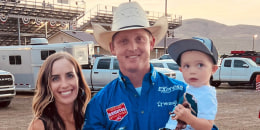
Levi Wright’s mom posts heart-wrenching obituary for son: ‘He was constantly thinking of others’
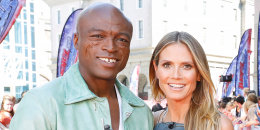
Heidi Klum’s children: What to know about her 4 kids she shares with ex-husband Seal
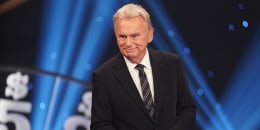
Who are Pat Sajak's 2 kids? What to know about ‘Wheel of Fortune’ host’s family

So. Many. Baldwins. Meet Alec and Hilaria’s whole family
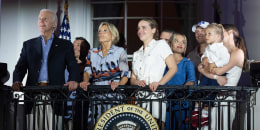
Joe Biden's kids: All about Beau, Hunter, Naomi and Ashley

Celtics star Jayson Tatum shares sweet moment with 6-year-old son after NBA Finals Game 1 win

Donald Trump's five kids and their three mothers
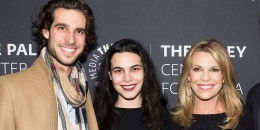
Who are Vanna White’s 2 kids? What to know about ‘Wheel of Fortune’ host’s family

Pregnant Swiftie shares sonogram of her unborn baby imitating Taylor Swift

Did ‘Bluey’ introduce its first gay couple? The history of LGBTQ+ representation in animated series
News | African lion cub, Lomelok, euthanized at…
Share this:.
- Click to share on Facebook (Opens in new window)
- Click to share on X (Opens in new window)
- Click to print (Opens in new window)
- Click to email a link to a friend (Opens in new window)
- Restaurants, Food and Drink
- Entertainment
- Immigration
- Sports Betting
News | African lion cub, Lomelok, euthanized at Lincoln Park Zoo after slow recovery from spinal surgery

Visitors brave the rain and dreary weather to see the three young cubs lounging with their father, Jabari, and other lions on heated rocks on, May 1, 2023, at Lincoln Park Zoo. The cubs turned 4 months old on May 9. (Brian Cassella/Chicago Tribune)

One of the young lion cubs bathes his brother Pilipili on May 1, 2023, at Lincoln Park Zoo. Cassella/Chicago Tribune)

Visitors brave the rain on a dreary spring day to see the lions, including three young cubs, lounging on heated rocks on May 1, 2023, at Lincoln Park Zoo. The cubs turned four months old on May 9. (Brian Cassella/Chicago Tribune)

Several of the lions, including the young cubs, watch visitors brave the rain and dreary weather on May 1, 2023, at Lincoln Park Zoo. (Brian Cassella/Chicago Tribune)

Shanna Madison / Chicago Tribune
Three lion cubs make their debut at the Pepper Family Wildlife Center on April 14, 2023, at the Lincoln Park Zoo in Chicago.

The first of three cubs gingerly enters the enclosure alongside its mother, Zari, for first time at the Pepper Family Wildlife Center on April 14, 2023, at the Lincoln Park Zoo. The cubs, all males, were born at the zoo Jan. 9 but have stayed behind the scenes, zoo officials said, with minimal human intervention. Three 3-month-old cubs named Pesho, Sidai and Lomelok will be on view to the public and exploring their habitat beginning April 15.

Lion cubs explore their new home at the Pepper Family Wildlife Center on April 14, 2023, at the Lincoln Park Zoo.

A child watches as three lion cubs are introduced to the Pepper Family Wildlife Center at the Lincoln Park Zoo.

Lion cubs explore their new home at the Pepper Family Wildlife Center at the Lincoln Park Zoo.

Jabari, the father of the three cubs, walks around the Pepper Family Wildlife Center on April 14, 2023, at the Lincoln Park Zoo.

People watch three lion cubs make their debut at the Pepper Family Wildlife Center on April 14, 2023, at the Lincoln Park Zoo in Chicago.

A lion cub explores its new home at the Pepper Family Wildlife Center.

Lomelok was born with a spinal defect that’s caused mobility challenges since he was a few weeks old, zoo officials said. He had an operation in March — the first of its kind on a lion cub — to reduce his pain and treat a herniated disc.
Lomelok’s recovery from the surgery was “slow and steady,” officials said, but he wasn’t “thriving” as he should. When veterinary staff detected a gastrointestinal obstruction that would have required another intensive surgery and a lengthy recovery, they made the “difficult but responsible decision” to euthanize Lomelok on Saturday.
“We have been overwhelmed by the support from the community for Lomelok throughout his health journey,” said Cassy Kutilek, the curator of mammals, in a Monday news release. “Lomelok’s name means ‘sweet’ in the Maa language, and that was the best way to describe him. There are no words to articulate how deeply he will be missed.”
Lomelok, who was roughly 2 pounds at birth , grew to more than 250 pounds. Zoo officials said he had started growing a thick adolescent mane. One of his favorite activities, officials said, was laying upside down and showing his white belly fur. His care team is “still processing this incredibly tough loss,” a zoo spokesperson said.
Lomelok and his two brothers, Pesho and Sidai, were born Jan. 9, 2023, at the Pepper Family Wildlife Center. His mother, Zari, gave birth after five hours of labor, earning her the title of “rock star” among zoo staff.
Lomelok’s family also included his older brother, Pilipili, his father, Jabari, and aunts Hasira and Cleo. Both of Zari’s pregnancies were part of the African Lions Species Survival Plan, a population management effort across accredited zoos within the Association of Zoos and Aquariums.
Zari “immediately attended to the cubs, started grooming them, and then, within hours of their birth, she started nursing them and feeding them,” the zoo’s curator of mammals and behavioral husbandry Mike Murray told the Tribune after the three cubs’ birth.
After some private time with little human intervention, the cubs made their public debut in April 2023, with much fanfare . Pictures and videos of Lomelok’s young life, from his birth to his first playful steps in a new home to his antics with a tree , circulated across the internet.

When Lomelok started to grow, staff were concerned about his rear limbs and lower-than-normal activity levels. He was eventually diagnosed with stenosis, which zoo officials said is the narrowing of channels that carry nerves from the spine to the legs.
“You can think of the spinal cord as a highway, carrying nerve signals from your brain out to the rest of your body,” Lomelok’s veterinarian Dr. Kate Gustavsen said in March. “Between every set of vertebrae, there are exits that the nerves leave from.”
“In Lomelok’s case, the last two exits all the way at the end of the highway have a lane closed in each direction — they’re too narrow, everybody’s irritated, the traffic is moving slowly,” she continued. “That’s causing what we see physically as his muscles not developing completely appropriately and him being clumsy in his gate, and it also causes some discomfort.”
Spinal conditions in the wild
In the wild, it’s unlikely that Lomelok would have survived very long with this condition, according to Craig Packer, a professor at the University of Minnesota and director of the Lion Research Center.
When a lion is small, its mother carries it in its mouth with its teeth around its nape. But as the cub ages, the mother would have stopped carrying it, he said. Packer estimated that Lomelok had at least an extra year of life because of his care in captivity.
“That cub would have been left behind. That cub would have either starved to death or been killed by a leopard or hyena or another lion from a neighboring pride,” Packer said. “So that animal had a much longer life than you ever would have seen in the wild.”

The challenges of surviving with this condition in the wild make it hard to know how common spinal birth defects are in lions, Packer said. Mothers keep their cubs hidden for the first few weeks of their lives, and he said some research suggests they will abandon one member of their litter.
“I’m not saying they are deliberately leaving behind disabled cubs, but I can’t say that’s impossible,” he said. “We have some evidence that they don’t always keep every single one of their cubs.”
The opportunity to see Lomelok, or any lion cub, in a zoo is a fairly rare treat because zoos have to carefully control breeding, Packer said.
“If you had a female lion who had the maximum number of surviving cubs, which would be four, and they can start breeding especially in captivity by the time they’re just a little over 2 years old, after about 37 years, the descendants would need to eat the population of Chicago every week,” Packer said.
“You can’t let them breed at their maximum, so it’s a special thing in captivity,” he added.
More in News

National News | A freighter ship in Lake Superior collided with something underwater, Coast Guard says

Environment | At the Chicago Botanic Garden, two pungent corpse flowers come to life

Weather | Scattered thunderstorms, showers expected on Saturday, officials say

Naperville Sun | Naperville police charge 2 men in separate gun-related incidents involving machine gun, fired weapon
Trending nationally.
- Is California the worst state for fast food operators?
- Sick checklist linked to Rex Heuermann, newly accused of 2 more slayings in Gilgo Beach case
- 3 moms sue Florida, saying state only helps parents who want books banned
- What’s up with the canceled tours and slow ticket sales for arena concerts?
- Giant Joro spiders could arrive in Massachusetts this year: ‘There’s no stopping them’

IMAGES
COMMENTS
The park. The Lion & Safari Park was originally a wildlife conservation enclosure for lions located in the Gauteng province in South Africa. In 2016, the park relocated to new premises of 600 hectare (ca. 1,500 acre) in the Cradle of Humankind in the North West province. The park is situated north of Lanseria Airport within driving distance of ...
African Lion Safari. / 43.341; -80.180. African Lion Safari is a family-owned safari park in Southern Ontario, Canada, located between the cities of Hamilton and Cambridge, located 100 kilometres (62 mi) west of Toronto. Guests may tour seven game reserves, with a total area of about 740 acres (300 hectares), on tour buses or in visitors' own ...
The San Diego Zoo Safari Park is a zoo in the San Pasqual Valley area of San Diego, California, ... History The San Diego Zoological Society became interested in developing a larger facility in 1964. ... Opened in October 2004, Lion Camp houses the park's six African lions, Izu, Mina, Oshana and Etosha in a 1-acre (0.40 ha) ...
Share the road with the King of Beasts. Lion Country Safari brochure. YESTER LION COUNTRY SAFARI (CALIFORNIA) HOURS: Open every day of the year, rain or shine, at 9 a.m. until: Summer — June 1 to Labor Day — 6:00 p.m. Fall — Day after Labor Day to October 31 — 5:00 p.m. Winter — November 1 to March 31 — 3:30 p.m.
The Lion Park has been a quintessential tourist spot that for half-a-century has had people visiting it, from all over the world. However, the park has shifted to a new location on the R512 Lanseria road, within the Cradle of Humankind from July 2016 onwards. It is now fondly referred to as Lion and Safari Park - an upgraded and first-rate ...
The next generation, brothers Stafford and Kenneth Bullen opened the family's first two African safari parks — one at Warragamba, New South Wales, in 1968 and another at Yatala, Queensland, in ...
Lion & Safari Park offers a remarkable array of activities for all ages. Visitors can enjoy exhilarating safari drives, getting up close to Africa's iconic creatures, from lions and cheetahs to zebras and hyenas. For those seeking more interaction, the park offers guided bush walks and opportunities to hand-feed friendly giraffes….
This timeline documents the 100+ year history of San Diego Zoo Wildlife Alliance, from the Zoo's inception in 1916 after the Panama-California Exposition, to the founding of the Safari Park, and beyond. ... First Asiatic lion cubs born at the Wild Animal Park (a Society first). 5/04/1983; ... Safari Park Elephant habitat expands to 5.5 acres ...
African Lion Safari® is a Canadian owned family business created in the name of conservation by the late Colonel G.D Dailley. The park opened its gates to the public on August 22, 1969 with 40 lions in 3 reserves; today the park houses in excess of 1,000 animals comprised of over 100 species. Our manner of exhibiting animals is completely ...
The Lion and Safari Park is a 600-hectare wilderness reserve offering visitors an incredible opportunity to get up close to many of South Africa's most iconic animals. Upon arrival, climb aboard a 4x4 safari vehicle for a one-and-a-half-hour game drive to see Africa's predators, including lions, hyenas, wild dogs, cheetahs and leopards.
Fifty years ago, visitors lined up for miles for the opening day of Lion Country Safari , a drive-through wild animal park that was the country's first cageless zoo. In its half-century history ...
"Trespassers will be eaten." It was the first of many grisly greetings for visitors to Bullen's African Lion Safari in the 1970s and 1980s. More than 30 lions and cubs once roamed the open-range ...
The lion stopped about a meter from the vehicle as Chappell continued taking pictures, a Lion Park statement said. The animal then lunged at the car, biting the woman through the open window. Tour ...
Photo: buzzlamp. In the 1970's, Tucked into a small corner of Laguna Nigel, there was once a place where wild animals roamed and for just a few dollars, you could drive your car through the park called Lion Country Safari. Photo: buzzlamp. The park was famous for its funny looking lion, Frasier. The amourous lion was a legend and became a ...
First opening in 1971, the park was established after Bullen's Circus stopped operating in 1969 - with many of the circus' wildlife going to similar parks across the country. Upon opening, it was home to a whopping 32 lions and four cubs, who were separated into two prides - the king being a mostly-tame male named Ferocious, or Fro for ...
Yes, we have wheelchairs available to rent for $5.00 and wagons available to rent for $8 at our Safari Bazaar Gift Shop, located underneath Kenya Gate! With each rental, a security deposit is applied, and refunded when the rental is returned. All rentals will be cleaned and sanitized before each use. More FAQs.
Lion Country Safari is a drive-through safari park and walk-through amusement park located on over 600 acres in Loxahatchee (near West Palm Beach), in Palm Beach County, Florida.Founded in 1967, it claims to be the first 'cageless zoo' in the United States.. In 2009, USA Travel Guide ranked Lion Country as the 3rd best zoo in the nation.
our story. Lion Country Safari opened in the summer of 1967 in rural Western Palm Beach County with dozens of free-roaming lions and a few other species. The drive-through safari park is believed to be the first cageless zoo in the country, introducing a new concept in zoology and bringing the experience of an African game park - then and now ...
All our programs are free (unless otherwise noted). They are open to the public after paying the park entrance fee. ($7 in-state & $12 out-of-state) All our Interpretive programs are listed in Central Time. The Nature Center's Current Hours: Open Daily 9:00 - 4:00 CT *Note that during peak visitation times, entry into our park might be delayed.
Amazing place. The animals are simply beautiful - all well-groomed and well-fed. For cat lovers, this is a paradise. Since there weren't so many people in Crimea this year, we decided to take a photo with a lion cub during this visit to the park. An unforgettable experience when you pick up this soft, huge cat.
Notorious male lion "Mr.T" of the Mapogo Coalition shows his teeth.Filmed in the Sabi Sand Wildtuin, Greater Kruger National Park, South AfricaSubscribe for more great wildlife clips: <a href ...
Companies like Everglades Safari Park make it possible to easily spot alligators, ... Lion Country Safari allows you to drive through a 4-mile safari inhabited by herds of animals. Giraffes, alpacas, lions, zebras, and ostriches are just a few of the many animals you can expect to see roaming the land. ... Florida's Black history encompasses ...
Reviews — Zoos in Europe. Moscow Zoo. During the second half of the nineteenth century the first menageries in Moscow were established as entertainment facilities. The first was founded in 1855 by two Frenchmen (names unknown), while the Kreuzberg family owned a private menagerie that opened its door to the public in ...
A family's close encounter with a giraffe at a Texas drive-thru safari park was captured on camera, showing the animal plucking a toddler out of the bed of their truck and several feet into the air.
History. The park is in the grounds of Longleat House, a stately home which is open to the public and is the home of the 8th Marquess of Bath. Longleat Safari Park and the concept of safari parks were the brainchild of Jimmy Chipperfield (1912-1990), former co-director of Chipperfield's Circus.. In 2022, Longleat welcomed the birth of a southern koala joey.
We have a newborn takin! We're not sure about the sex yet, but a baby takin is always good news. Takins are rare animals in European zoos, especially this very subspecies — Sichuan takin. The animal is on the IUCN Red List. VENOMOUS BEAUTY.
A 17-month-old African lion cub at the Lincoln Park Zoo, known for his sweet and laid-back personality that captured the hearts of thousands in Chicago and on social media, has died following a slo…
As the sun begins to sink, male lions awake and stretch, leopards come down out of the trees and antelope move closer together. At 6 p.m. the guides park for a "sundowner" stop, toasting with wine, gin-and-tonics, crackers and cheese. A male lion roars and you shiver down to your toes. A second lion answers.
Moscow Zoo Museum. Founded in 2008 in a two-storey building of the 19th century, built in the late XIX - early XX centuries, located on the territory of the zoo. Since 2015, the museum has been open to the public and everyone. In the central and side halls there is an exposition devoted to the history of the Moscow Zoo and a natural science ...